#I love that all of his live action adaptations have all been visually memorable
Explore tagged Tumblr posts
Text
Batman Villain Movie Ideas, Part XXII: The Penguin
Oswald Cobblepot AKA The Penguin is the first of our final four, four villains who have been done and done and done again, all being mostly strong adaptations of said character. Oswald is normally portrayed as a portly funny-looking man with a bird fetish who runs the Iceberg lounge, a front for his criminal activities and a regular hangout for other villains throughout the series. I . . . don't know what Tim Burton was doing with the character. I think he combined him with Killer Croc's backstory maybe. Either way, if it weren't for Danny DeVito's stellar performance, I'd have more of an issue with his portrayal there.
Origin Movie: I think Gotham did it about right. Having him be loosely connected to the more regular mob bosses, allowing Bruce to start out taking out the crime families and such that have infested Gotham, while still having a more colorful and iconic villain rise to the top in the end.
Sequel Movie: Honestly, the origin fits him a little better, unless you're going the old Burton series of just working down through the villains by level of iconography: Joker first, Penguin or Catwoman second, yada yada. He could still work, especially if the first movie had Batman take out the bigger crime families which created a power vacuum that Penguin filled.
Finale Movie: Unless it's like a run on the Iceberg Lounge as a stronghold for all the villains, this seems like the worst spot for him.
Supporting Villain: This is basically what he's best at, and is literally what his setup with the Iceberg Lounge practically exists to do, and its likely the biggest reason for his remaining as prolific as he has. He is a great supporting villain.
Overall, here are my rankings of them:
Supporting Villain: He's really good at it.
Origin Movie: The best way to do a grounded "take on crime" origin while still having an iconic villain.
Sequel Movie: Not as great, but it's there.
Finale Movie: If he is anything, he is not a finale villain.
What do you think? Who should I cover next?
#oswald cobblepot#penguin#batman#batman movie#bruce wayne#I love that all of his live action adaptations have all been visually memorable#Even though he's functionally a normal dude#Heavy makeup is always a requirement to do him justice
1 note
·
View note
Text
20,000 Leagues Under the Sea (1954)
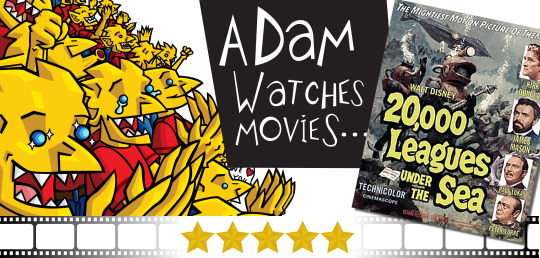
When you hear the words “Classic Disney”, your mind immediately jumps to the studio's many animated films but have you ever taken a peek at some of the live-action works in the library? 20,000 Leagues Under the Sea is a wonderful adventure, full of memorable characters and terrific special effects. It perfectly captures the thrill and imagination of the novel by Jules Verne, making it splendid entertainment for the young and old.
In 1868, a series of disasters in the Pacific Ocean lead the nations of the world to believe a sea monster prowls the waters. While investigating, Professor Aronnax (Paul Lukas), his assistant, Conseil (Peter Lorre) and master harpooner Ned Land (Kirk Douglas) discover the monster is actually a man-made “submerging boat”. The Nautilus is responsible for these attacks and now, the men are prisoners/guests of its captain: Nemo (James Mason).
Those who’ve already seen the film probably remember it best for a spectacular sequence during the second half. The Nautilus is deep underwater when a giant squid attacks. Generally, the illusions used to bring the Nautilus to life are quite good but in this scene, you’ll wonder how director Richard Fleischer pulled it off. I’m sure that inevitably, we’ll get a big-budget remake (or rather, another adaptation) of the novel and when we do, I wonder if the matching scene will have the same impact as this one. Sure it will look slick thanks to modern special effects but here? You can tell the people are actually struggling against the water, the wind and the physical animatronic.
This is a great-looking picture. The Technicolor process makes even mundane objects like the sailor's red hats pop and underwater footage has never looked better. There’s a scene that shows how Nemo and his crew harvest the sea bed for food. It isn't crucial to the story, but the footage is so clear no editor in their right mind would ever dream of cutting it. Seeing the men in their deep-sea suits gathering seaweed, using nets to calmly wrangle a school of fish or guide a sea turtle is nothing short of breathtaking because you know those are real people and real animals being filmed. I'm certain more than one oceanographer could tell you that scene is what made them choose their career because they saw it as a kid. The wonders aren’t limited to the outside either. The interior of the Nautilus is a wonderful place full of ndetails that will make you fall in love with the aesthetic of steampunk (even though technically, the submarine is nuclear-powered).
But ultimately, all of these visual flairs wouldn’t mean much if it weren’t for a great story and most importantly, great characters. Captain Nemo is such a compelling… hero? villain? anti-hero? On the one hand, he seems sympathetic. All he wants is to be left alone so he and his crew can keep living on the ocean. Then, you remember that to ensure his solitude, he indiscriminately attacks whatever vessels get too close. He is technically keeping the Professor, Conseil and Ned prisoner but the very fact that he didn’t just kill them shows how classy a guy he is. Much credit is to due to the extremely charismatic James Mason. Long stretches of the film simply concern day-to-day life aboard the Nautilus and Conseil and Ned's attempts to escape - the Professor being (understandably) too mesmerized by everything around him to bother. That sounds like it could be boring but it never is. In fact, this is the kind of movie you hope never ends.
If there’s one aspect of 20,000 Leagues that might not have aged as well as the rest, it’s a brief sequence where Nemo allows Ned and Conseil above sea level to explore an island. He warns them that cannibals live there. In real life, there have never been cannibal societies and the myth has racist connotations. Ned and Conseil do, in fact, encounter hostile natives, though whether these are actual cannibals could be up for debate, as mounting skulls on pikes as a warning against intruders is something many societies have done and both men suspect Nemo just said there were cannibals to discourage them from wandering too far. I'll give it the benefit of the doubt.
1954’s 20,000 Leagues Under the Sea has aged surprisingly well. The special effects are excellent and the underwater photography is crystal-clear - something even modern blockbusters struggle with. It’s a thrilling adventure that captures the imagination thanks to the source material by Jules Verne - faithfully adapted by Earl Felton - and director Richard Fleischer, who keeps the pace consistent despite the episodic nature of the story. Best of all, it features an excellent and memorable performance by James Mason. How good he is cannot be understated. This is a new favorite for me. (August 9, 2022)
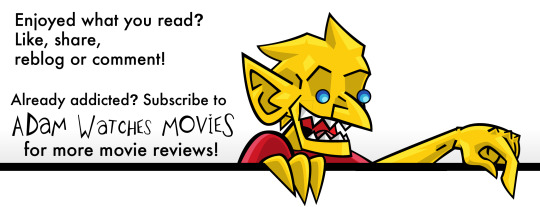
#20 000 leagues under the sea#movies#films#movie reviews#film reviews#Richard Fleischer#Earl Felton#Jules Verne#Kirk Douglas#James Mason#Paul Lukas#Peter Lorre#1954 movies#1954 films
5 notes
·
View notes
Text
Christopher Lee: A Sinister Centenary - Number 24
Welcome to Christopher Lee: A Sinister Centenary! Over the course of May, I will be counting down My Top 31 Favorite Performances by my favorite actor, the late, great Sir Christopher Lee, in honor of his 100th Birthday. Although this fine actor left us a few years ago, his legacy endures, and this countdown is a tribute to said legacy! Today’s Subject, My 24th Favorite Christopher Lee Performance: Blind Pew, from Treasure Island (1990).
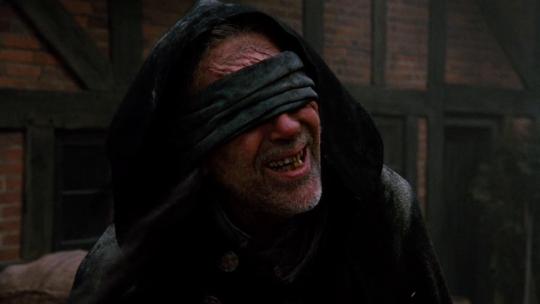
Our previous pick, Dr. Wilbur Wonka from “Charlie and the Chocolate Factory,” was an example of a case where Lee had a fairly small part, but made a big impression. This entry is another example of the same. Robert Louis Stevenson’s classic novel “Treasure Island” has repeatedly been hailed as “The Greatest Adventure Story of All Time” (capital letters included there), and it’s not really a surprise why: it is, without a doubt, the pirate story to end all pirate stories. Aside from perhaps Peter Pan, no other piece of fiction involving pirates has been quite as influential as this book: so many character, plot, and aesthetic tropes for these kinds of tales have come from this one story. For those who don’t know, the book is told from the perspective of a young fellow named Jim Hawkins: the son of an innkeeper who ends up roped into a wild adventure involving mutinous pirates and lost treasure. It’s a fairly simple premise, but the characters and events make it a remarkably memorable and powerful tale. The story has been adapted numerous times to film; perhaps the three most popular versions (and my personal favorites, besides) are the ones produced by Disney. However, beyond the three Disney incarnations – a live-action film from the 1950s, a Muppet movie, and a sci-fi/space fantasy animated reimagining entitled “Treasure Planet” – perhaps the most revered and well-known version of the story put to the screen is the 1990 TV film production, which starred a young Christian Bale as Jim Hawkins, in contrast to a much older Charlton Heston as the infamous Long John Silver. As much as I love all three Disney versions, what I think the 1990 version excels at most is creating a much more gritty, vicious take on the story, just speaking aesthetically. In the book, Jim refers to his adventures as “a nightmare” – the whole ordeal was a scary, traumatizing time for him, not a wild or wacky time for him to cherish. The Disney versions, as you would expect, ignore this fact, but the 1990 movie takes a less romantic spin on things, with much more brutal and graphic visuals that bring a sense of gritty realism to the story: it’s telling that Jim keeps his line about the nightmare at the end of the film, and it’s this more realistic and gruesome spin that has earned the film its kudos over the years. Nowhere is this more nightmarish spin on the classic story more clearly emphasized than with Christopher Lee’s appearance as the tertiary antagonist of the story, Blind Pew. Pew has always been one of the more unsettling characters in the novel, and most incarnations stick to that ideal pretty well (even the Muppet version is a LITTLE creepy). Cloaked in black, his eyes covered by a velvet band, the sightless Pew automatically strikes one as an unnerving figure as he shambles through the fog…but his hapless, pitiful state cause Jim Hawkins to feel sympathy for him, not recognizing the danger till its too late. Pew doesn’t take long to reveal his dangerous side: he’s surprisingly strong and not nearly as helpless as his disabled status would indicate, and manages to scare Captain Billy Bones to death…literally! Having Lee take on this role was a work of genius: though Pew’s time in the story is relatively short, the simple casting choice of this man in this part makes him not only the definitive screen portrayal of the character, but one of the most memorable parts of the whole picture. He has the right elements of cunning, menace, and slimy fiendishness the character requires, but also manages well in Pew’s more vulnerable moments, where his namesake blindness gets the better of him. He sets the tone for the movie, beyond anyone else: this won’t be a fun ride on the high seas, and the road for Jim that lies ahead will be fraught with even worse dangers than the sinister blind beggar…including another deceitful pirate with his own physical inabilities that can lead one astray…but that’s another story. Tomorrow the countdown continues with My Number 23 choice!
#sinister centenary#may special#christopher lee#happy birthday christopher lee#top 31 christopher lee performances#best#favorites#list#countdown#number 24#movies#tv#literature#treasure island#treasure island 1990#blind pew
12 notes
·
View notes
Text
Tian Guan Ci Fu
where is it and what is it
it’s a chinese webnovel by mxtx, the same author who did untamed; it exists as a webnovel, finished and kindly translated here, the manhwa, the donghua (animated adaptation) happening right now, and there’s a live action adaptation in plans, directed by the same guy who did untamed. the donghua is gorgeous, the adaptation i’m unsure about but prepared to be hopeful, the manhwa seems to be very pretty. but all the adaptations only cover the very beginning of the novel for now, so i went ahead and read the novel, and i have no regrets. it helps that the translation is very good - not without awkward translatorese, but it has consistent and engaging flow and style, and it’s also pretty good at conveying mxtx’s humor without awkwardness. it reads pretty well.
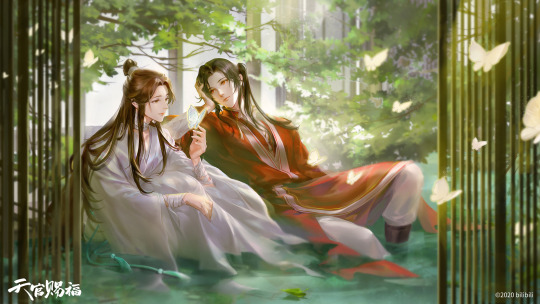
what’s it about?
the world is split into two parts: mortals and various ghosts and demons and entities share the land, while ‘heaven officials’, aka gods, live in the heavenly kingdom in the sky. pretty much anybody can become a god if they do something really heroic or memorable and/or cultivate (meditation, training, virtuous behavior) really hard. when above, the gods rule their domains and fulfill their believers’ wishes; they work sort of like pratchettian gods, dependent on their followers’ beliefs and getting influenced by them. heavens are strictly hierarchical, with their own economy and pecking order, and the gods aren’t particularly sinless or benevolent; mostly it’s a question of scale.
our hero, xie lian, is a prince of a prosperous kingdom who’s been on a fast track to ascension for most of his very short life; he’s talented, he’s virtuous, he’s kind, he’s strong, and his only peculiar flaw is (somehow naive, but well-meaning) obsession with equality and value of human lives and so on. he becomes a god, unexpectedly, at seventeen, after slaying one especially dangerous god, and rises in heaven at the peak of his faith, influence and happiness.
…and then he finds out about drought and incipient trouble in his own kingdom, and, being a young and righteous god too close to his mortality, eschews heavens and returns to save everybody. it, to put it lightly, does not go well. at all. in fact, it goes catastrophically wrong, and, having lost everything, xie lian ascends again, only to get into a fight with the heavenly emperor, and get banished again, this time for good. he roams the mortal lands for next eight hundred of very lonely, luckless and hard years, technically immortal but not invincible, with his powers and his luck stripped away, and leans to make do, eking out a living as a scrap collector. his temples are desecrated, his name is forgotten, his kingdom is long gone, and - well. so it goes.
so it goes! until one day, to everybody’s great surprise, he ascends once again: a humble, gentle, immune to embarrassment, unflappable man, an embarrassment to heavens, a 'laughingstock of three realms’ who just wants to be left well enough alone. he’s Tired.
instead of rest, he gets sent to investigate a dangerous ghost stealing brides who pass through its mountain, and there, during the course of the interrogation, has his first (he thinks) meeting with a terrifying, old-powerful and vengeful ghost king named hua cheng, who likes to terrorize heavens from time to time. but said ghost king seems to be very benevolent and very interested in helping xie lian, and xie lian is pretty instantly smitten… with knowing what’s the cause of such interest.
…and meanwhile, in the beginning, there'was an unlucky boy, born under the worst stars, whom xie lian saved from falling once, while still mortal, and promptly lost track of. a lot of things happened to this boy, who wanted to be the most devoted worshipper to xie lian the god of the sword and the flower. as one does, you know.
that’s the beginning! from there on: investigations, heavenly secrets, old friends and enemies and acquaintances, thematic parallels, old tragedies, more pining than you can shake a stick at, grand acts of love.

is it good?
it’s very, very good. it’s the first fantasy cnovel i read (aside from the hilarious one about a guy traveling back in his own timeline and becoming a sugar baby to a mafia boss, which was in a very different league), so i don’t know which things are baseline and which things are unique, but it had a very solid foundation: ambitious multilevel, multi-timeline plot coming together in the end both events- and emotions-wise, beautifully iddy main relationship, maybe multifaceted characters who change and grow and clash together in fun ways, a clear and heartfelt understanding of its own core themes.
it’s also, unexpectedly, very funny, in this visual, slapsticky, begs-to-be-adapted way - i found myself laughing out loud over it a lot of times, and it possesses this gift of swerve between understated but earnest emotions and all-out jokes that i associate with… a bit of prattchett and a bit of gintama, honestly. take it as you will.
(oh my god the mecha. i will laugh over this one until i die.)
it also made me cry several times; granted, it’s not like it’s this time, but those were very heartfelt tears.
and the main duo?
first let me say that xie lian was lifted out, wholesale, out of my deepest character preferences. he fell really, really far, and did some bad things, and some very horrible things were done to him, and by the time we meet him he went through everything and achieved this effortless kind of traumatized, humble, accepting, wryly self-deprecating, utterly competent chill that makes a character incredibly appealing to me. he’s kind, and he’s sweet, and he’s gotten any possible embarrassment at least a couple of centuries ago, and he kinda made peace with himself and kinda didn’t. i love him.
and, thankfully for me, hua cheng, the ghost king, loves him a whole damn lot, a ridiculous amount, an epic, over-the-lifetimes, life-shattering amount, and he’s a terrifying presence to everybody else and a shy, protective, sweet dork to xie lian, and every time they’re together on page my entire heart is just. it’s AMAZING. he’s a great combination of playing the obsessive protective yandere stalker-lover trope straight and putting it on its head, by making hua cheng not just revere but respect xie lian, in all his good and bad decisions.
they are just so - good for each other, holy shit. they get each other so well. they’re the best ever power team. i love them.
(the rest of canon is various character reenacting “really? in front of my salad?” meme at them. it’s hysterical, and it’s the best. everybody teams up to tell xie lian that his boyfriend is Problematic way, way before xie lian clues into the fact that he does have a boyfriend, and he’s having none of it. i love it.)
and the themes?
okay, so. roughly half of this novel is ridiculous iddy pining, and a fourth of it is various tropes (off the top of my head: soulbond, sex pollen, body switch, de-age, various shades of identity porn… crossdressing…) played very shamelessly. but it also really benefits from having an overarching set of ethical questions, and while it deals with them a bit shounen-style, it still deals with them, and it makes the whole text fresh, and sweet, and bold.
is it possible to save everybody? should you try to save everybody? if you lack the powers to back your convictions, does it make you complicit? when is it possible to stop the cycle of suffering, what can you do if you want to but can’t? if you tried and people you failed turned on you, whose fault it is, where does the blame stop?

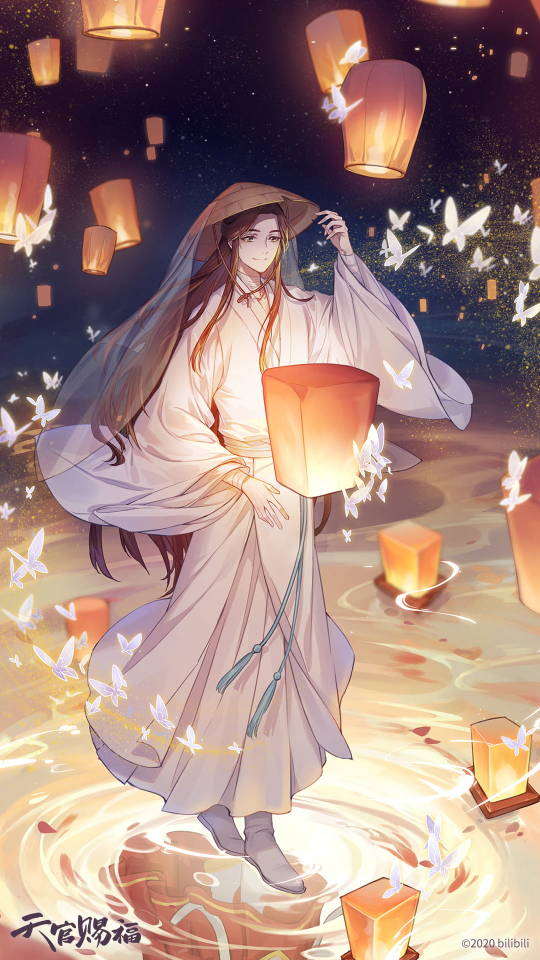
Detailed spoilers begin from here, and i would REALLY advise to stay unspoiled, because the domino reveals are very fun
i loved the various ways the novel sets all those pieces up and then overturns them and then returns to them. xie lian wanted to save everybody and it was arrogant naivete of an untried, untested, privileged young man who never had a real challenge before; his presence made things escalate quicker, and yet everybody around him pretended it was his attempt to make things better that ruined everything, and not a combination of factors outside of his control. and yet he accepts the blame, because it dovetails with his shame at not having enough powers to back his intent up; and yet his triumph over bai wuxian is that he doesn’t, after all, renege on his initial drive to help people.
my most favorite part of this novel is that its turning point, the lynchpin of the whole novel, the moment that keeps xie lian’s soul and safety intact, is not his personal purity and drive; it’s not even hua cheng’s devotion and sacrificial love. it’s just a moment of little, grudging, human kindness from a little, petty, rude man whom the history will sweep away soon. the bamboo hat in the rain. the rest of the plot keeps twisting and turning and coming back to itself, but this? this was unquestionably, beautifully clear, and i loved it. it’s never about the gods, it’s all down to - fallen human is human, ascended human is human, and human is not some state, virtuous or sinful, you get stuck with - it’s a multitude of choices, and there’s never a final one.
and incoherent spoilery screaming for people who read it already
oh my god i had SO MUCH FUN. i’ve been flailing on meme for days, because somebody just finished reading there too, and i’m still bursting with ALL THE FEELS. ruoye origins oh my god! that hat! jin wu’s backstory and ultimate end! e-ming’s praise kink! pei ming’s little shippery 'hoho’! hua cheng’s horribly handwritten stick and poke tattoo of xie lian’s name! the lanteeeeeeeeeeeeerns. feng xin and mu qing on the bridge, making up with each other and with xie lian! hua cheng trying to explain to xie lian that his habit of using himself as bait and pincushion at any given moment is deeply emotionally upsetting to him, and succeeding! banyue’s learning from xie lian to be a truly horrible cook! the entire deal with shi qingxuan and he xuan and the wind fan in the end. THE CAVE. THE GIANT MECHA. aaaaaaaaaaaaaaaaaaa and aaaaaaaaaaaaa and aaaaaaaaaaaaaaaaaa and i am beset, beset by feelings. come scream with me.
149 notes
·
View notes
Text
Spring 2021 Anime Season
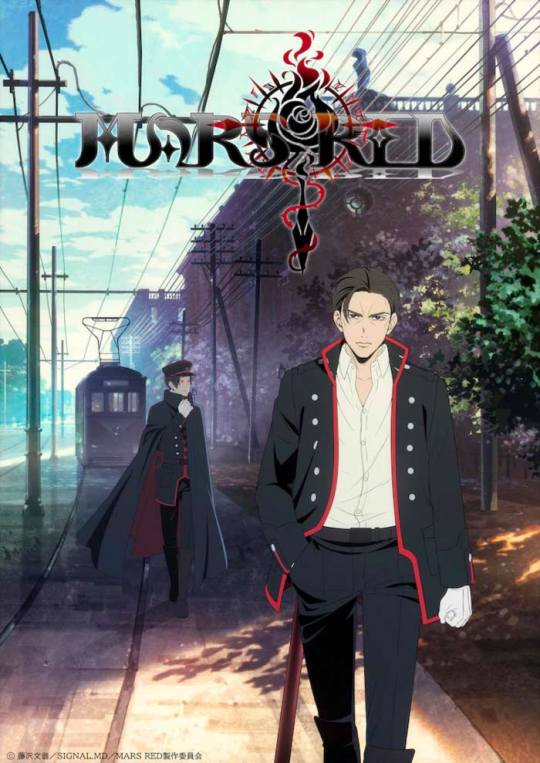
Mars Red is one of two series this season set in one of my favorite periods, the Meiji era. It’s a vampire series that deals a lot with the politics of war as the Japanese military is attempting to establish a vampire unit, supposedly to compete with the British vampire unit (because of course that’s a thing). It focuses on a human military officer named Maeda who is charged with recruiting and managing vampires. Maeda is the type of character I really enjoy. Handsome, a little older than most anime protagonists, chain-smoking, overly serious, and voiced by Junichi Suwabe (who has to have the sexiest voice in all of anime). The series has a classic, romantic feel to it. Its take on vampires is somewhat traditional (they evaporate in the sun, drink blood, sleep in coffins, have super strength and speed, etc.). If it brings anything new to the table, it’s the concept of vampires having different ranks, from S-class down, and how lower ranks naturally fear higher ranks. Still yet, the classic vibe works in the show’s favor. Combined with the historical setting, it gives the show a certain charm. The art is lovely, from the backgrounds to the character designs, and the music is a high point. It easily has the best ending theme of the season.

Fumetsu no Anata e (To Your Eternity) is a unique series. I’ve seen a lot of people comparing it to Mushishi, but with an overarching plot, and that assessment is pretty accurate. The show follows an entity that comes to be known as Fushi. It begins as an orb, and as it makes contact with other objects and creatures, it learns from them and can possibly take their forms. Among the forms it most often takes are a white wolf and a young man. Originally, it’s a somewhat empty shell, incapable of communicating, but as it meets different creatures and learns, it develops a personality and begins to speak. The series is, overall, about Fushi’s journey through this world and all the experiences it gains, both wonderful and tragic. There’s a subtle beauty to the series, with an early focus on nature, but it also has scenes of trauma and violence. The animation is fluid and the facial expressions are amazing. There’s an overall natural feel to it that, like others have pointed out, reminds me of Mushishi (though it’s definitely faster paced than Mushishi). The show also likes to make you cry, so keep that in mind.

Joran: The Princess of Snow and Blood is the other series set in the Meiji era this season, albeit an alternate version of it that has a strange form of technology. To be honest, I’m a little fuzzy on some of the details, but it seems to be about a group called the Nue who work for the government to fight against a growing rebellion. The main character is Sawa, a member of Nue who has some sort of special powers involving her blood, which allow her to transform and battle monsters, or whatever else stands in her way. Her goal is to get revenge for the death of her entire clan (implied to be wiped out because of their power). Sawa is a decent heroine, a woman who craves vengeance and is determined to get it through any means, but is, at her core, a compassionate person who would rather live in peace. It’s this internal conflict that makes Sawa compelling (even if it’s not entirely original). The other characters are interesting, particularly Tsuki, whom I won’t talk much about because it would involve spoilers. The plot and details can get a little convoluted, but the action and animation are solid. When Sawa transforms, the art style changes, and it’s a really cool visual effect. The music is also nice.
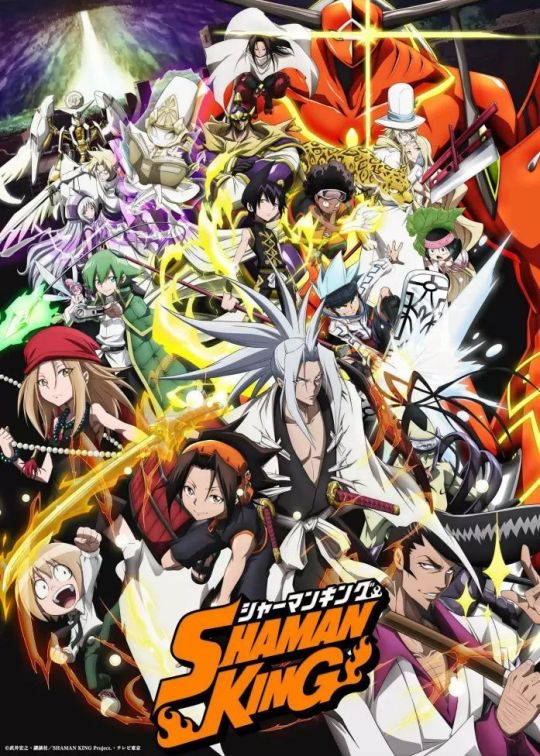
Shaman King received a remake this season. I was a huge fan of the original, and so far I’m enjoying the remake, but to be honest, I’m having trouble seeing the point. The art is almost the same (just a lot shinier), the voice actors are the same, the plot is the same. Maybe it’s just that it’s been so long since I saw the original, I’m unable to remember the details and so I can’t tell what’s different. But to me it feels like I’m just rewatching the show. Which is fine, because I loved it to begin with. Maybe it gets different later on. Maybe it more closely follows the manga. I’ll keep watching to find out. For anyone new to the series, it looks like the remake is a solid place to start if you want to get into it. I won’t go into plot details for a story this old, so I’ll just say it’s a top tier shounen fighting series with a unique art style and some very memorable characters. If you like that sort of thing, and missed the original (or you just want a refresher), definitely check it out!
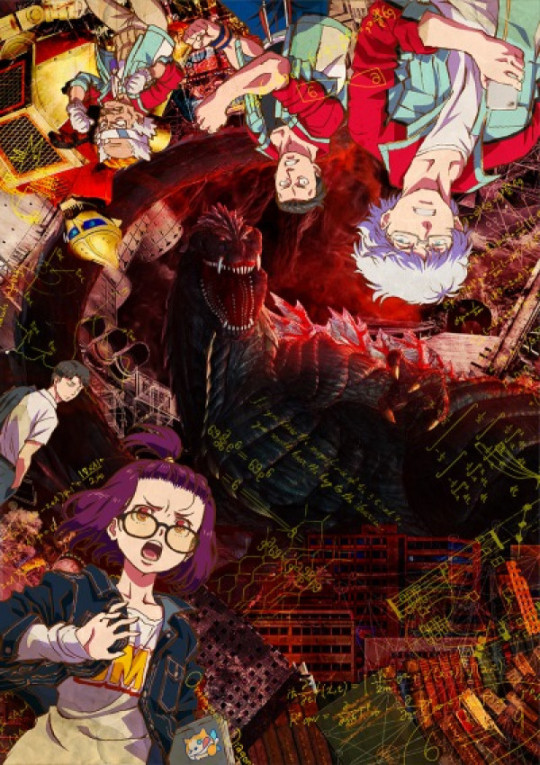
Godzilla Singular Point is a true delight. I’m a huge Godzilla (and kaiju in general) fan. I’ve watched every single Godzilla movie, as well as all the related movies (the Mothra films, Rodan, etc.), but I never watched the previous Godzilla anime that was on Netflix a few years ago. It just didn’t sound like something I’d like. Singular Point, however, is right up my alley. Set mainly in a small seaside town that’s suddenly attacked by bird-like monsters known as Rodans, we have two geeky protagonists using their intelligence to figure out what’s going on while more and more monsters appear. Mei and Yun are excellent heroes. They rely on their wits rather than physical strength, which is a refreshing approach. It’s also interesting that they have little to no face-to-face interaction. Instead, they chat with each other via text as they work separately. They often challenge each other with science questions. It’s adorable. The show’s overall feel is fairly upbeat and energetic. The colorful art and peppy character designs by Kazue Kato (who did Blue Exorcist) help with this feel. It should be noted that Godzilla himself doesn’t fully appear until halfway through the series. It says a lot about the quality of the show that I don’t actually mind that at all. Some of the science stuff does go over my head, but the general plot is easy enough to follow and the action is very well done. It also has fantastic music, with my favorite opening theme of the season. Even if Godzilla isn’t your thing, consider giving this series a shot if you like nerdy science types as heroes.
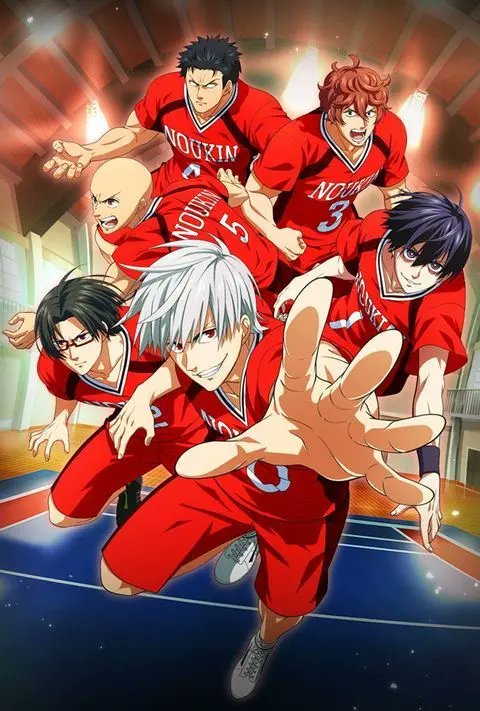
Burning Kabaddi is a sports anime about an unsual sport. I’d never heard of it before now, and if people in the comments were not talking about the very real sport, I would have assumed it was made up for the anime. The show is aware that the sport is obscure, so it takes great pains to explain the rules and details so that we can all follow the action. The story centers on Yoigoshi, a soccer prodigy who decides to drop all sports once he gets to high school due to all the drama and angst that surrounded him (mostly due to his teammates being jealous of his talent), and pursue a career as a streamer. All the various sports clubs at the school want to recruit him (especially the soccer club, of course) because they’ve heard of his skill and he has an athletic build. He rejects them all, but the Kabaddi club is strangely relentless. He ends up being manipulated into joining (the vice captain of the team straight up blackmails him by threatening to show his online streaming account to the whole school). Despite this rocky beginning, Yoigoshi actually starts to enjoy playing Kabaddi, and more importantly, begins to bond with his new teammates. It’s pretty fun stuff that doesn’t take itself too seriously. The art is serviceable for a sports anime and the music is fine. The series isn’t going to blow your mind, but it’s a fun way to spend twenty minutes every week. Worth a watch if you have a weakness for hot blooded sports anime.

The World Ends With You finally got its anime adaptation and I was so excited. The game is one of my all-time favorites. So far the anime is pretty good. The art is a near perfect replication of the bold, thick-lined art of the game. The battles are exciting and cool. Best of all, the anime often uses music from the game. This is important because the game has one of the best soundtracks, ever. Every time I recognize a song from the game, I almost squeal. If I had a complaint, it’s that the pacing feels a little off at times. It feels like the anime is rushing through the story, but that’s understandable. In the game, it took longer for everything to happen because you were walking from place to place, fighting battles along the way, stopping to scan NPC’s, shopping at stores, spending time in menus, etc. The anime has to cut most of that out, so naturally things are going to move faster. The result is that you don’t get to spend as much time with these characters, and so you feel less attached to them. Anyone watching the anime who didn’t play the game might feel like the emotional beats are lacking. I feel like this anime is definitely meant to be enjoyed by fans of the game, rather than newcomers to the story. But if you are a fan of the game? You should be watching this every week. It’s an excellent refresher on the story, just in time for the second game to come out this summer. Super high on my watch list.

Boku no Hero Academia has a new season. To be honest I don’t remember what number we’re on. This season, so far, focuses on a tournament-style competition between the two main hero classes. I would much prefer the plot to move on to something more exciting involving the villains, but I suppose they have to throw arcs like this in every so often just to remind everyone of which characters have which quirks. The plus point is that instead of being an individual competition, it’s team-based. What this ultimately means is that characters that are viewed as weaker or having more obscure quirks actually get a chance to shine. These are characters who definitely aren’t going to win one-on-one battles. In an individual tournament, it’s pretty much a given that characters like Deku, Bakugou, and Todoroki are going to win most of the matches. But in a team, everyone has to work together. The end result is that the lady characters, all of whom have fairly weak or situational quirks, finally FINALLY get to actually do stuff! Even better, in several of the match-ups, the girls have taken the lead in planning and strategizing. It’s been pretty nice to watch. The girls from the other class have been very proactive as well. I really wish the girls could do more in “real” battles with villains, since it’s clear that they can step up when they need to. Who knows? Maybe this is a sign of good things to come.
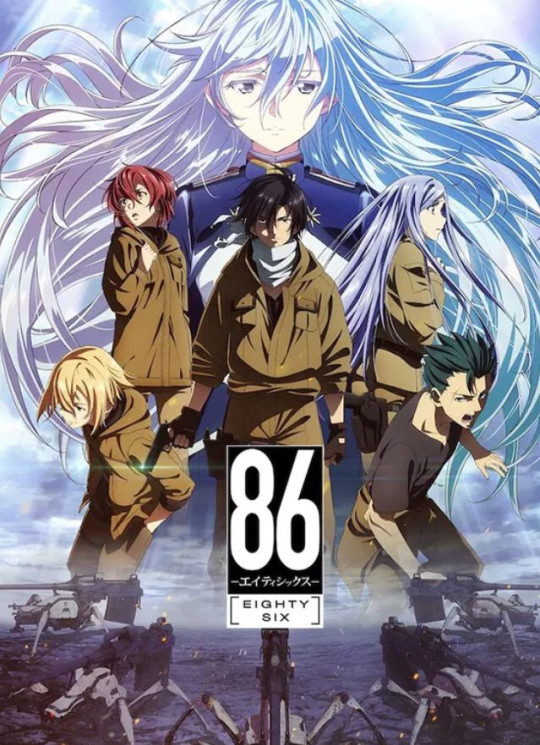
86 is a new mecha/sci-fi anime based on a series of light novels. The setup is fairly cool: In a country where everyone has silver hair and eyes, the people live in what looks like a utopia. There is a war going on outside their protected land but all combat is performed by automated robots, so there are no human casualties... or so the government would have the people believe. In reality, there is a district that exists on the outskirts of the country called 86, where people who don’t have silver hair and eyes are sent to pilot the robots and fight to protect the country that shunned them. Most of the pilots are children or teenagers. The mortality rate is high. Only a few people in the government know of their existence, mostly military types that include “handlers”. These handlers each take on an 86 unit and communicate with them through a system called “para-raid”. Using this, they monitor the battlefield from their safe positions and issue commands. Naturally, most handlers view their units as nothing more than tools in the war, and most 86-ers view their handlers as privileged snobs who know nothing of actual battle. The real plot kicks in when Lena, a young Major, becomes the new handler for a particular 86 unit. Lena is sympathetic to the people of 86, but it’s going to be hard getting her notoriously rough unit to accept her. The plot is a bit complicated and the show deals with some weighty themes (racism, privilege, war, child soldiers, death). Lena is a likable enough heroine and the members of 86 are all interesting and fairly well written. The music is fine. The art... well, it’s pretty to look at, but it feels a bit generic to me. A bit too shiny. The mecha designs are great, but I’m not crazy about the character designs, which feel like they could be from any other modern anime. I also find it sad but hilarious at the same time that the women’s military uniforms are clearly designed for fanservice (they include mini skirts, thigh-highs with garters, and a short jacket that opens up just above the chest to show the tight shirt underneath) while the men’s uniforms are just totally normal military wear. To be honest it’s just too stupid to actually be offensive, so it comes across as comical. Thankfully, the interesting setup and plot carry the show, making it good enough to overlook the generic visuals.
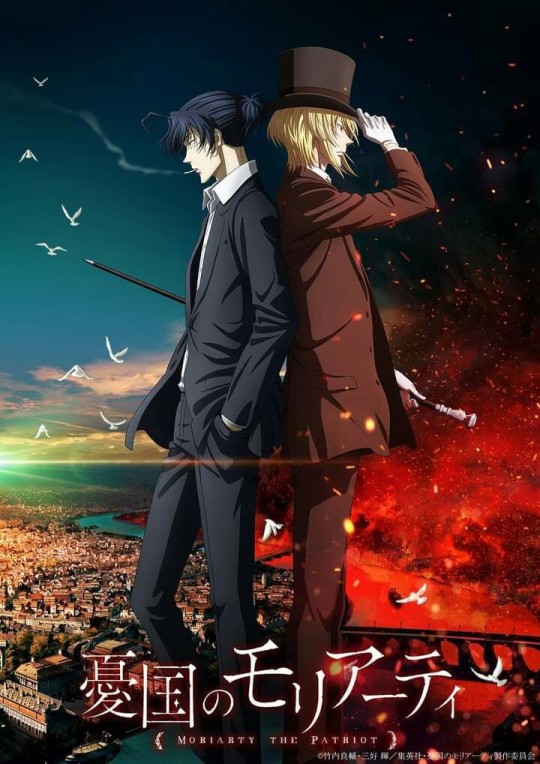
Moriarty the Patriot has a new season... maybe? I think it’s technically still season one, but with a split cour. Regardless, it feels like a new season so I’m treating it as such. The series focuses on famous Sherlock antagonist Moriarty, here represented as a trio of handsome brothers (though one of them is clearly the protagonist and the leader of the group) who work as “crime consultants” and basically help the lower classes wage class warfare against the nobility. This season shifts the focus away from the individual crimes Moriarty concocts and instead focuses on larger-scale conflicts that involve government conspiracies, corrupt cops, etc. We’re also treated to a lady James Bond (finally!), fixing one of the very few complaints I had about the first cour (that it lacked strong lady characters). The show remains very compelling, with beautiful art and excellent new opening and ending themes.
Best of Season:
Best New Show: Godzilla Singular Point
Best Opening Theme: Godzilla Singular Point
Best Ending Theme: Mars Red
Best New Male Character: Maeda (Mars Red)
Best New Female Character: Sawa (Joran)
#Anime Reviews#Spring 2021 Anime#Seasonal Anime Reviews#Seasonal Anime#Anime#Text#Godzilla Singular Point#Mars Red#moriarty the patriot#Fumetsu no anata e#Burning Kabaddi#86
39 notes
·
View notes
Photo

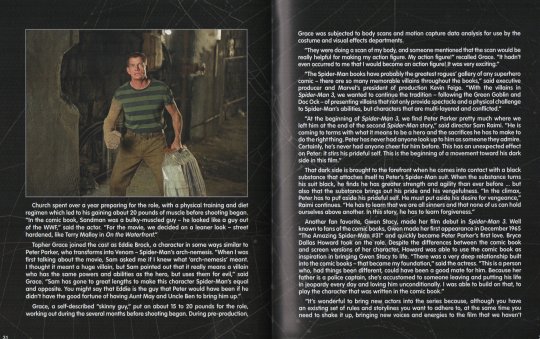

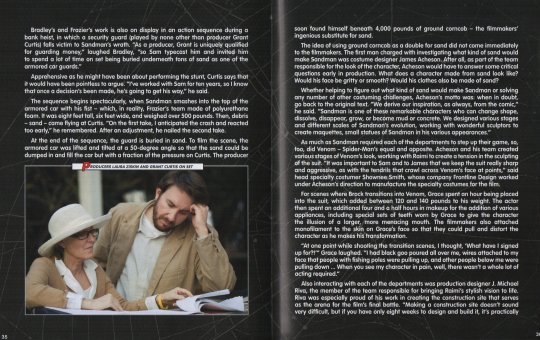
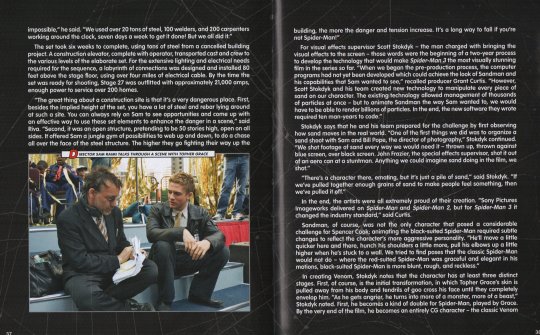
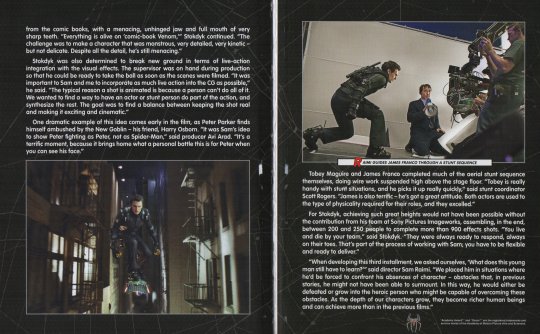
From the booklet which comes with the Spider-Man Trilogy Limited Edition Collection blu-ray!
This talks about the making of Spider-Man 3, here’s the bit about the first Spider-Man movie and here’s the bit about Spider-Man 2.
Click for a transcript:
OLD FRIENDS… AND NEW FACES
“The heart of the Spider-Man films has always been the depth of the characters and their interconnected lives. Peter’s love of Mary Jane Watson and his friendship with Harry Osborn have always been the richest parts of our stories,” said director Sam Raimi.
In Spider-Man 3, Peter Parker faces his biggest challenge to date – and the greatest battle of all is the battle within himself.
“We wanted to explore the darker side of Peter’s character,” said producer Laura Ziskin. “When his suit turns black, it enhances and emphasizes characteristics that are already in the host. In this case, it makes him stronger and quicker, but also more prideful and aggressive.”
“When I read the script I was really excited about the different direction we were going with Peter Parker and the other characters and storylines,” said Tobey Maguire, who returned to the role of Peter Parker. “We are covering a lot of new ground here, with a fresh take on the story while maintaining the continuity of the characters from the previous two films.”
In Spider-Man 3, Spider-Man takes on two classic villains: Sandman, who first made his appearance in the fourth issue of “The Amazing Spider-Man” and Venom, one of the comic book’s most memorable villains.
“Marvel comic books – and especially the Spider-Man books – have always had a great bunch of villains to choose from,” noted Raimi. “So many great Marvel artists and writers developed these characters. It was a very easy task to pick up these wonderful tales and images and develop our story from them.”
Thomas Haden Church played Flint Marko, a man haunted by the mistakes of his past, who is caught in a physics experiment gone wrong. “I consider it an honor, really,” said Church, an Academy Award nominee for his role in Sideway, on joining the franchise. “The Spider-Man films stand tall in the pantheon of superhero movies. Many are called, few are chosen, and I’m proud to be one of the few.”
“Flint Marko becomes Sandman when he stumbles into a radioactive test site where they’re performing a molecular fusion experiment and he accidentally becomes fused with sand,” Church added. “As a result, he can change his shape and adapt to his environment. He can be 10, 30, 80 feet tall. He can form giant sand fists, hammers, a mace. He can shift into a sand tornado, or sift into sand. He is as malevolent and menacing as any villain can be.”
Church spent over a year preparing for the role, with a physical training and diet regimen which led to his gaining about 20 pounds of muscle before shooting began. “In the comic book, Sandman was a bulky-muscled guy – he looked like a guy out of the WWF,” said the actor, “For the movie, we decided on a leaner look – street hardened, like Terry Malloy in On the Waterfront.”
Topher Grace joined the cast as Eddie Brock, a character in some ways similar to Peter Parker, who transforms into Venom – Spider-Man’s arch-nemesis. “When I was first talking about the movie, Sam asked me if I knew what ‘arch-nemesis’ meant. I thought it meant a huge villain, but Sam pointed out that it really means a villain who has the same powers and abilities as the hero, but uses them for evil,” said Grace. “Sam has gone to great lengths to make this character Spider-Man’s equal and opposite. You might say that Eddie is the guy that Peter would have been if he didn’t have the good fortune of having Aunt May and Uncle Ben to bring him up.”
Grace, a self-described “skinny guy,” put on about 15 to 20 pounds for the role, working out during the several months before shooting began. During pre-production, Grace was subjected to body scans and motion capture data analysis for use by the costume and visual effects departments.
“They were doing a scan of my body, and someone mentioned that the scan would be really helpful for making my action figure. My action figure!” recalled Grace. “It hadn’t even occurred to me that I would become an action figure! It was very exciting.”
“The Spider-Man books have probably the greatest rogues’ gallery of any superhero comic – there are so many memorable villains throughout the books,” said executive producer and Marvel’s president of production Kevin Feige. “With the villains in Spider-Man 3, we wanted to continue the tradition – following the Green Goblin and Doc Ock – of presenting villains that not only provide spectacle and a physical challenge to Spider-Man’s abilities, but characters that are multi-layered and conflicted.”
“At the beginning of Spider-Man 3, we find Peter Parker pretty much where we left him at the end of the second Spider-Man story,” said director Sam Raimi. “He is coming to terms with what it means to be a hero and the sacrifices he has to make to do the right thing. Peter has never had anyone look up to him as someone they admire. Certainly, he’s never had anyone cheer for him before. This has an unexpected effect on Peter: it stirs up his prideful self. This is the beginning of a movement toward his dark side in this film.”
That dark side is brought to the forefront when he comes into contact with a black substance that attaches itself to Peter’s Spider-Man suit. When the substance turns his suit black, he finds he has greater strength and agility than ever before… but also the substance brings out his pride and his vengefulness. “In the climax, Peter has to put aside his prideful self. He must put aside his desire for vengeance,” Raimi continues. “He has to learn that we are all sinners and that none of us can hold ourselves above another. In this story, he has to learn forgiveness.”
Another fan favorite, Gwen Stacy, made her film debut in Spider-Man 3. Well known to fans of the comic books, Gwen made her first appearance in December 1965 “The Amazing Spider-Man #31” and quickly became Peter Parker’s first love. Bryce Dallas Howard took on the role. Despite the differences between the comic book and screen versions of her character, Howard was able to use the comic book as inspiration in bringing Gwen Stacy to life. “There was a very deep relationship built into the comic books – that became my foundation,” said the actress. “This a person who, had things been different, could have been a good mate for him. Because her father is a police captain, she’s accustomed to someone leaving and putting his life in jeopardy every day and loving him unconditionally. I was able to build on that, to play the character that was written in the comic book.”
“It’s wonderful to bring new actors into the series because, although you have an existing set of rules and storylines you want to adhere to, at the same time you need to shake it up, bringing new voices and energies to the film that we haven’t experiences before, “noted Raimi. “It gives the audience a new experience, with the characters they love, but with a new energy dynamic, with those new faces on screen with them.”
“In terms of logistics and scope, Spider-Man 3 is by far the largest of the three films,” said Ziskin. “Sam has really upped the ante for this film, in terms of action sequences and visual effects involving Sandman and Venom, so it is a gigantic endeavor, with over 1,000 people working towards that goal.”
During production, Raimi relied on key members of his filmmaking team to bring to life before the cameras as much of Peter Parker’s story as possible. “Whenever it’s safe and practical, I like to capture the action in camera,” said Raimi. “Visual effects are an amazing tool for action that human beings can’t do – but if a human being can do it, let’s do it.”
The talented team of stuntmen was ready, but so was the cast. Bryce Dallas Howard, especially, surprised the filmmakers by being game for anything they could throw at her. At one point, the actress found herself hanging from a harness.
After performing several portions of the sequence on soundstages in Los Angeles, Howard was eager to get in the harness again to fly with Spider-Man over Sixth Avenue. “What’s so great about movies is you get to really experience these crazy, crazy stunts, things that you would never emerge from alive in real life,” says Howard. “I knew I would be 100% safe because Sam and the stunt team really protect the actors. So I tried to do as many things as possible, because it’s really fun and a great adrenaline rush!”
Thomas Haden Church was also up to the challenge – in fact, even more so. Whether it was being yanked five feet in the air so he could do a face-plant in the mud, or being chased (and caught) by dogs, or dangling off the side of a set, or falling onto train tracks, or having his face smashed into a pane of Plexiglas, the actor found himself bruised and battered repeatedly, but was ready for anything. According to producer Grant Curtis, “It wasn’t intentional, but it seemed sometimes like if any actor was required to get beat up in any way, Thomas was always drawing that short straw.”
Two members of the production team that played key roles in ensuring that these action sequences were both as safe and as spectacular as possible were special effects supervisor John R. Frazier (who previously served in the same capacity on the first two Spider-Man films) and second unit director Dan Bradley (a veteran of Spider-Man 2). “Working with Sam is like going back to school,” said Frazier. “You have that moment where you say, ‘Oh, this is going to be really, really hard, but a lot of fun.’ It’s not unusual for me to be on a movie like Spider-Man 3 for nine months, from the beginning planning stages through production.”
One scene that highlights their work is the Subway Drain portion of an elaborate fight sequence between Spider-Man and Sandman. Raimi worked closely with Frazier, Bradley and visual effects supervisor Scott Stokdyk on the sequence, in which Sandman is blasted by the force of a burst water pipe and, quite literally, goes down the drain. Sam wanted Sandman to melt away, in essence, during this sequence.
“This is the largest water gag for one shot I’ve ever done for a film,” recalled Frazier, who had previously supervised the special effects for Poseidon. “We used 50,000 gallons of water, shooting out of a pipe which blasted the rear of the set fifty feet away. When you see this sequence, the water appears to be a six-foot-thick column of water; however, we made the center of the pipe hollow, and used a restrictor plate to control the size of the column of water. The water is recirculated using pumps, which are able to pump 3,000 gallons a minute. We can fill both tanks in about five minutes, so that we are ready for another take.”
The sequence was covered using eight cameras, according to Stokdyk. “This sequence is where Spider-Man discovers Sandman’s weakness – water. We had to put a CG Sandman in here because the velocity of the water is too great to have Thomas Haden Church or a stuntman perform portions of the sequence. Water is a huge challenge for visual effects, especially on a large scale, so our goal here was to seamlessly integrate the elements for the sequence between practical and CG.”
Bradley and Frazier’s work is also on display in an action sequence during a bank heist, in which a security guard (played by none other than producer Grant Curtis) falls victim to Sandman’s wreath. “As a producer, Grant is uniquely qualified for guarding money,” laughed Bradley, “so Sam typecast him and invited him to spend a lot of time on set being buried underneath tons of sand as one of the armored car guards.”
Apprehensive as he might have been about performing the stunt, Curtis says that it would have been pointless to argue. “I’ve worked with Sam for ten years, so I know that once a decision’s been made, he’s going to get his way,” he said.
The sequence begins spectacularly, when Sandman smashes into the top of the armored call with his fist – which, in reality, Frazier’s team made of polyurethane foam. It was eight feet tall, six feet wide, and weighed over 500 pounds. Then, debris – sand – came flying at Curtis. “On the first take, I anticipated the crash and reacted too early,” he remembered. After an adjustment, he nailed the second take.
At the end of the sequence, the guard is buried in sand. To film the scene, the armored car was lifted and tilted at a 50-degree angle so that the sand could be dumped in and fill the car but with a fraction of the pressure on Curtis. The producer soon found himself beneath 4,000 pounds of ground corncob – the filmmakers’ ingenious substitute for sand.
The idea of using ground corncob as a double for sand did not come immediately to the filmmakers. The first man charged with investigating what kind of sand would make Sandman or solving any number of other costuming challenges, Acheson’s motto was: when in doubt, go back to the original text. “We derive our inspiration, as always, from the comic,” he said. “Sandman is one of those remarkable characters who can change shape, dissolve, disappear, grow, or become mud or concrete. We designed various stages and different scales of Sandman’s evolution, working with wonderful sculptors to create maquettes, small statues of Sandman in his various appearances.”
As much as Sandman required each of the departments to step up their game, so, too, did Venom – Spider-Man’s equal and opposite. Acheson and his team created various stages of Venom’s look, working with Raimi to create a tension in the sculpting of the suit. “It was important to Sam and to James that we keep the suit really sharp and aggressive, as with the tendrils that crawl across Venom’s face at points,” said head specialty costumer Shownee Smith, whose company Frontline Design worked under Acheson’s direction to manufacture the specialty costumes for the film.
For scenes where Brock transitions into Venom, Grace spent an hour being placed into the suit, which added between 120 and 140 pounds to his weight. The actor then spent an additional four and a half hours in makeup for the addition of appliances, including special sets of teeth worn by Grace to give the character the illusion of a larger, more menacing mouth. The filmmakers also attached monofilament to the skin on Grace’s face so that they could pull and distort the character as he makes his transformation.
“At one point while shooting the transition scenes, I thought, ‘What have I signed up for?!’” Grace laughed. “I had black goo poured all over me, wires attached to my face that people with fishing poles were pulling up, and other people below me were pulling down… When you see my character in pain, well, there wasn’t a whole lot of acting required.”
Also interacting with each of the departments was production designer J. Michael Riva, the member of the team responsible for bringing Raimi’s stylish vision to life. Riva was especially proud of his work in cresting the construction site that serves as the arena for the film’s final battle. “Making a construction site doesn’t sound very difficult, but if you have only eight weeks to design and build, it’s practically impossible,” he said. “We used over 20 tons of steel, 100 welders, and 200 carpenters working around the clock, seven days a week to get it done! But we all did it.”
The set took six weeks to complete, using tons of steel from a cancelled building project. A construction elevator, complete with operator, transported cast and crew to the various levels of the elaborate set. For the extensive lighting and electrical needs required for the sequence, a labyrinth of connections was designed and installed 80 feet above the stage floor, using over four miles of electrical cable. By the time the set was ready for shooting, Stage 27 was outfitted with approximately 21,000 amps, enough power to service over 200 homes.
“The great thing about a construction site is that it’s a very dangerous place. First, besides the implied height of the set, you have a lot of steel and rebar lying around at such a site. You can always rely on Sam to see opportunities and come up with an effective way to use these set elements to enhance the danger in a scene,” said Riva. “Second, it was an open structure, pretending to be 50 stories high, open on all sides. It offered Sam a jungle gym of possibilities to web up and down, to do a chase all over the face of the steel structure. The higher they go fighting their way up the building, the more the danger and tensions increase. It’s a long way to fall if you’re not Spider-Man!”
For visual effects supervisor Scott Stokdyk – the man charged with bringing the visual effects to the screen – those words were the beginning of a two-year process to develop the technology that would make Spider-Man 3 the most visually stunning film in the series so far. “When we began the pre-production process, the computer programs had not yet been developed which could achieve the look of Sandman and his capabilities that Sam wanted to see,” recalled producer Grant Curtis. “However, Scott Stokdyk and his team created new technology to manipulate every piece of sand on our character. The existing technology allowed management of thousands of particles at once – but to animate Sandman the way Sam wanted to, we would have to be able to render billions of particles. In the end, the new software they wrote required ten man-years to code.”
Stokdyk says that he and his team prepared for the challenge by first observing how sand moves in the real world. “One of the first things we did was to organize a sand shoot with Sam and Bill Pope, the difrector ofg photographer,” Stokdyk continued. “We shot footage of sand every way we would need it – thrown up, thrown against blue screen, over black screen. John Frazier, the special effects supervisor, shot it out of an aero can at a stuntman. Anything we could imagine sand doing in the film, we shot.”
“There’s a character the, emoting, but it’s just a pile of sand,” said Stotdyk. “If we’ve pulled together enough grains of sand to make feel something, then we’ve pulled it off.”
In the end, the artists were all extremely proud of their creation. “Sony Pictures Imageworks delivered on Spider-Man and Spider-Man 2, but for Spider-Man 3 it changed the industry standard,” said Curtis.
Sandman, of course, was not the only character that posed a considerable challenge for Spencer Cook; animating the black-suited Spider-Man required subtle changed to reflect the character’s more aggressive personality, “He’ll move a little quicker here and there, hunch his shoulders a little more, put his elbows up a little higher when he’s stuck to a wall. We tried to find poses that the classic Spider-Man would not do – where the red-suited Spider-Man was graceful and elegant in his motions, black-suited Spider-Man is more blunt, rough, and reckless.”
In creating Venom, Stokdyk notes that the character has at least three different stages. First, of course, is the initial transformation, in which Topher Grace’s skin is pulled away from his body and tendrils of goo cross his face until they completely envelop him. “As he gets angrier, he turns into more of a monster, more of a beast,” Stokdyk noted. First, he becomes a kind of double for Spider-Man, played by Grace. By the very end of the film, he becomes an entirely CG character – the classic Venom from the comic books, with a menacing, unhinged jaw and a full mouth of very sharp teeth. “Everything is alive on ‘comic-book Venom,’” Stokdyk continued. “The challenge was to make a character that was monsterous, very detailed, very kinetic – but not delicate. Despite all the detail, he’s still menacing.
Stokdyk was also determined to break new ground in terms of live-action integration with the visual effects. The supervisor was on hand during production so that he could be ready to take the ball as soon as the scenes were filmed. “It was important to Sam and me to incorporate as much live-action into the CG as possible,” he said. “The typical reason a shot is animated is because a person can’t do all of it. We wanted to find a way to have an actor or stunt person do part of the action, and synthesize the rest. The goal was to find a balance between keeping the shot real and making it exciting and cinematic.”
One dramatic example of this idea comes early in the film, as Peter Parker finds himself ambushed by the New Goblin – his friend, Harry Osborn. “It was Sam’s idea to show Peter fighting as Peter not as Spider-Man,” said producer Avi Arad. “It’s a terrific amount, because it brings home what a personal battle this is for Peter when you can see his face.”
Tobey Maguire and James Franco completed much of the aerial stunt sequence themselves, doing wire work suspended high above the stage floor. “Tobey is really handy with stunt situations, and he picks it up really quickly,” said stunt coordinator Scott Rogers. “James is also terrific – he’s got a great attitude. Both actors are used to the type of physicality required for their roles, and they excelled.”
For Stokdyk, achieving such great heights would not have been possible without the contribution from his team at Sony Pictures Imageworks, assembling, in the end, between 200 and 250 people to complete more than 900 effects shots. “You live and die by your team,” said Stokdyk. “They were always ready to respond, always on their toes. That’s bit of the process of working with Sam, you have to be flexible and ready to deliver.”
“When developing this third installment, we asked ourselves, ‘What does this young man still have to learn?’” said director Sam Raimi. “We placed him in situations where he’d be forced to confront his absences of character – obstacles that, in previous stories, he might not have been able to surmount. In this way, he would either be defeated or grow into the heroic person who might be capable of overcoming these obstacles. As the depth of our characters grow, they become richer human beings and can achieve more than in the previous films.”
#spiderman#spiderman 3#behind the scenes#tobey maguire#sam raimi#interviews#bryce dallas howard#thomas haden church#topher grace#laura ziskin#michael riva#scott stokdyk#avi arad#john frazier#grant curtis#sandman#flint marko#venom#eddie brock#gwen stacy#george stacy#peter parker#harry osborn#special effects#set design
41 notes
·
View notes
Text
The Walking Dead, “Days Gone Bye” | Analysis
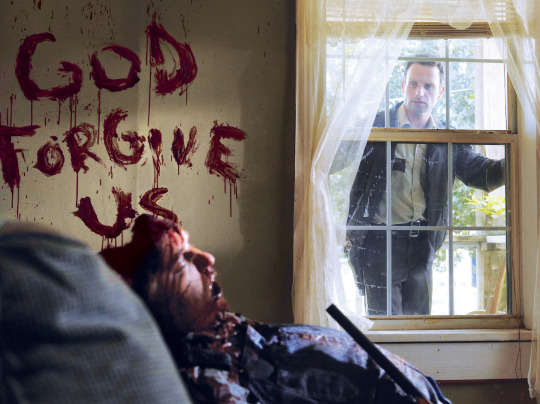
The final season of The Walking Dead comes in August, so I decided to rewatch the show from the beginning as the end is nigh. TWD has been a part of me since I started to watch TV series, and I’ve watched Days Gone Bye more than seven times, so this is certainly one of the pieces of audiovisual media that I’ve consumed the most. To add a new interesting layer in my rewatches, I’ve decided to see the episodes with a critical and analytical lens, seeing it more than just as a pastime, and write my thoughts here. This will be a great ride for me, and I can’t wait to see again some iconic moments from TWD throughout the seasons and write about them.
Part 1: The World Before
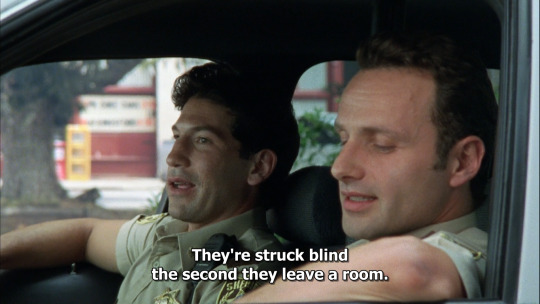
Before getting into the first act of the episode, let me talk about the teaser – the first five minutes of the episode – quickly. As this is our introduction to the world of TWD, Days Gone Bye couldn’t simply start with Rick and Shane having a chat. So it was necessary that the teaser served as a way to establish both the tone and setting of this story, and it certainly does. The teaser tells us that what we are watching is a gritty survival horror story that takes place in a post-apocalyptic world, and the teaser establishes this perfectly without no more than two lines of dialogue. It is established visually: Rick stops his car on a deserted road with no traces of civilization anywhere, then goes to an abandoned gas station where other cars are – and those cars have dead bodies inside. From there, we know right from the start that this isn’t the world we live in. When Rick sees the young girl that is in fact a walker, it is established that this is a world where the main threat are zombies. At least for some part, as in future episodes the series will show us something far more scarier than walking cannibal dead bodies is the real danger.
Now storytelling-wise, TWD already proved its value in the first five minutes. Frank Darabont directed the episode and wrote the script, and his work in the episode both as director and writter is fantastic and set the bar high if the series wanted to have a consistency of greatness in its episodes. After the perfect five minutes purely composed of visual storytelling, the first scene of the first act is dialogue-heavy and character-driven. One would think that it is to establish to us that Rick and Shane are friends, that Rick has a wife and son and that they are cop buddies, and one would be right, but it is also more than simply introduction and exposition, and that’s the beauty of the audiovisual medium as a whole.
Reading books about screenplay writing, I’ve come to know more about subtext and its applications in both movies and series. Despite this first scene doing great work in introducing us to the two main characters of the season – their mindset, persona and some backstory – it also adds so much worldbuilding-wise. Shane goes on his rant about women not switching off the lights in a house before leaving it, and Rick talks about a discussion he and Lori had earlier. See, the teaser showed us a decaying world with walking bodies. Now, the first minutes of act one show us a world where people worry about such trivialities: switching off the lights. In the tagline for the first volume of the comic book, it reads “The world we knew is gone. The world of commerce and frivolous necessity has been replaced by a world of survival and responsibility“. The scene I mentioned is basically the live-action adaptation of it. We see the world of commerce and frivolous necessity in this introduction so we can understand better and fear the world of survival and responsibility that will come later in the episode. TWD started geniously: it went from visually-driven to dialogue-driven, and after that to visually-driven storytelling, all without losing its verisimilitude and charm.
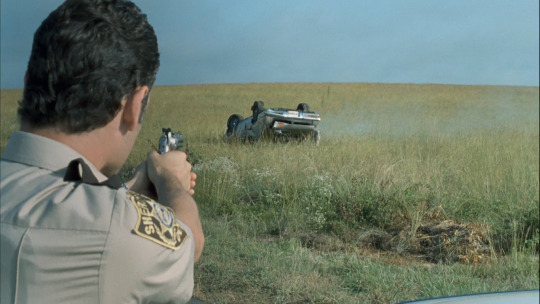
Now, something about the visuals I loved: the grainy aspect. Because this episode was shot on film – in fact, up until season ten all episodes were shot on film – the film grain is obviously visible. But instead of being just an aesthetic choice – shooting in film or digital – I think it’s also meant to have implications tone-wise. The comic books this series adapt is in black-and-white (something unusual in American comics), but it’s because the writer Robert Kirkman wanted the comic to feel like a classic George Romero zombie flick, and it worked completely. Commercially, a black-and-white TV series wouldn’t be much embraced by a large and mainstream public, but I think that Darabont solved that problem and succeeded in maintaining an aesthetic similar to the feel the comic book wanted to transmit. The excessive film grain – something that made me feel like watching a Panos Cosmatos’ movie but without the acid trips – works because it resembles the Romero zombie flicks in color, like Dawn of the Dead. It is a classical and archetypal zombie story – even if it subverts some conventions various times throughout the series – and the visuals tell us that.
Not only that, but the episode has many moments that resembled The Mist in some ways: the camera being close to its characters to make the story feel grounded and experienced by real people, the back shots to make the audience feel like they are following the characters in their journeys, the handhold camera moments that gives a documentary feel, adding a realistic perspective. All that grants a grounded vibe to the episode, which works because this is a story about how people react and live in a lawless world which can kill them at any possible moment without any warnings. It’s where chaos and anarchy reigns and where death always lurks. A story like that works better when it’s experienced through the eyes of the characters. It’s also best represented in the moment where Rick leaves the hospital and sees the sun for the first time. In the shot, the Sun is blinding us with its shining light, but then there’s a cut, and in the next shot we see only Rick covering his eyes while the blinding sun rays don’t make it to the camera. It’s the switch of subjective to objective perspective, as in the first we see the world with Rick eyes – it’s a man getting out of the dark for the first time in months – and in the second we see the same moment but from outside lens, and it showed us that this a day like any other where the sun doesn’t blind you. Besides, this episode has a low budget sensitivity – not meaning that the quality is subpar, but that it has an authenticity that is extremely convincing. It is that low budget quality that makes the story feel real in a certain way. That is, of course, until the tank in the middle of a city is shown, but even with the realism, it is still tangible, and the story continues to feel realistic in its depiction of a zombie apocalypse in the “real world”.
Not only that, but the episode has many moments that resembled The Mist in some ways: the camera being close to its characters to make the story feel grounded and experienced by real people, the back shots to make the audience feel like they are following the characters in their journeys, the handhold camera moments that gives a documentary feel, adding a realistic perspective. All that grants a grounded vibe to the episode, which works because this is a story about how people react and live in a lawless world which can kill them at any possible moment without any warnings. It’s where chaos and anarchy reigns and where death always lurks. A story like that works better when it’s experienced through the eyes of the characters. It’s also best represented in the moment where Rick leaves the hospital and sees the sun for the first time. In the shot, the Sun is blinding us with its shining light, but then there’s a cut, and in the next shot we see only Rick covering his eyes while the blinding sun rays don’t make it to the camera. It’s the switch of subjective to objective perspective, as in the first we see the world with Rick eyes – it’s a man getting out of the dark for the first time in months – and in the second we see the same moment but from outside lens, and it showed us that this a day like any other where the sun doesn’t blind you. Besides, this episode has a low budget sensitivity – not meaning that the quality is subpar, but that it has an authenticity that is extremely convincing. It is that low budget quality that makes the story feel real in a certain way. That is, of course, until the tank in the middle of a city is shown, but even with the realism, it is still tangible, and the story continues to feel realistic in its depiction of a zombie apocalypse in the “real world”.
The whole sequence of the car chase and the shooting between the cops and the criminals is beautifully conducted by Darabont, who knows his craft remarkably and executes it in a manner like no one else does. The memorable shots, shot by Darabont, immortalize the whole sequence and reach its climax – the gunshot Rick suffers – perfectly in a crescendo that works better here than in the comics, this being an easy task, but still, Darabont managed to do it in an impressive way, totally deserving a bravado status.
Also, something that I also appreciated, and I think it’s overlooked: when the police cruiser where Rick and Shane are passes through a road, we see a single crow eating a roadkill. What do this mean exactly? Animals can’t turn to zombies so one might think this is only a moment with no meaning behind it. But now I interprete it as a symbol. It is meant to represent that society has be decaying long before the dead came to eat the living. It remembers me the first Mad Max, where the world is not in the same level as it appears in Mad Max 2: Road Warrior – a full-on post-apocalyptic society – but it is in its final stages, leaning to barbarism and uncontrollable chaos. The producers of TWD announced an anthology spin-off series named Tales of the Walking Dead, and it certainly would be interesting to see more of the transition between our world and the post-apocalyptic zombie-ridden world, showing the process in-between of transformation and decay.
Part 2: Brave New World
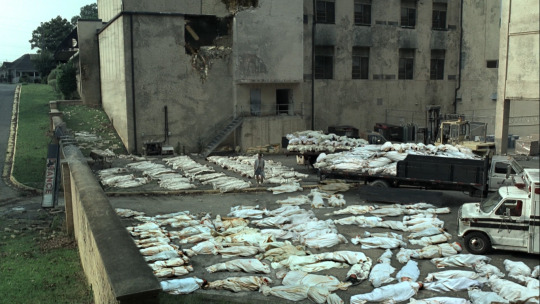
The second act starts as Rick steps out of the hospital and faces the current reality of his world, and it’s an ugly one. Rick sees dead bodies everywhere and discarded military gear. Something dreadful happened when he was in a coma. The world undergone a change so great in his sleep that it’s impressive that Rick didn’t drown in total madness when he first saw what’s left of society. Most of act two is about Rick having to come to terms with his new life: one entirely ruled by survival. Now, another interesting element that is also a symbol in my interpretation: the bicycle girl. The bicycle girl (which is the zombie without its lower body) is the first walker Rick encounters. He is scared by her and runs away from her with the bicycle that was there next to him. The bicycle girl is nothing more than the remains of the past life of Rick and the world before. It is dead and alive at the same time – like the walkers – but in a pitiful state. It can’t be on its feet and is always trying to grasp and touch Rick, but, ultimately, it can’t. Rick fears it, and because of that he runs.
Most of the second act is focused on the interactions of Rick and Morgan Jones. Morgan, after encountering Rick and saving him from a nearby walker, takes him inside his house, but fearing that the gunshot wound was in fact a walker bite, Morgan rightly tied Rick to a bed and waited for him to wake up to ask some questions. Now, it’s incredible how this episode never misses a beat and is not made of only three truly great scenes, but all of the scenes are great. The whole dinamic of Morgan explaining to Rick what happened and what it takes to live in this new world felt so natural that no critic could say it was bad exposition. It was exposition done right, revealing more about Morgan’s character, showing him as a good man and a father to his son Duane. It’s easy to understand why Rick and Morgan liked each other one day after meeting for the first time. The chemistry is real, and it’s unbelievable how seasons later, when they see each other again, the chemistry is still there.
Andrew Lincoln and Lennie James are spectacular actors. Their acting in this episode is astonishingly extraordinary. I’m pissed that they didn’t won any awards for it, they certainly deserve it. Andrew’s acting was great all way through, but when he first arrives at his house and cries for Lori and Carl you could feel the man’s pain and suffering. One moment that is perfect and maybe one of the bests of all TV history is when Rick is having an existential crisis. “Is this real? Am I here?”, asks Rick while facing the ground. It’s such a powerful reaction to the absurdity he is experiencing and it feels so damn real because Andrew Lincoln can cry like a pro and give the gaze of a man that is lost. Rick is lost. And this scene can provide such a powerful punch to the audience that you can’t help but be already invested in Rick’s journey. He just wants his family, so he can put some sense in a mad world. Without them, Rick is lost.

The second act makes us empathize more with Rick and Morgan. They both have admirable goals. They just want to live and provide for their family. Their bond is developed exceptionally in their final moments together – before Rick travels to Atlanta – that you are left caring for them and wanting a reunion. The final scenes of act two were made to make you feel emotional without doubt, and I’m sure that it worked on some people and made them fall in love with the series instantly. It’s when Rick kills bicycle girl and Morgan fails to kill his dead wife, now a walker. The soundtrack by Bear McCreary is phenomenal and adds so much dramatic and emotional weight to the scenes, and it fits perfectly with the tone of pretty much the core of the series. It’s a haunting song, a sorrowful one full of melancholy, but it also has a spark of hope in it. It makes a statement: everything is sadly collapsing around us, but there’s still hope of rebuilding. The Mercy of the Living is TWD summarized in an orchestral piece, and I feel like crying every time I listen to it, just like the piece Alive Inside of Telltale’s game, that also does a masterful job in creating a sad but hopeful atmosphere in its melody. The bicycle girl – which is the past Rick and the world before – must be killed by Rick if he wants to continue his voyage, to which destination is his family. Rick is teary and heartbroken in killing bicycle girl because now he has to fully embrace a life ruled by survival. “I’m sorry this happened to you.” is Rick final message and requiem to the world and consequently to his past self – a quiet Rick that didn’t want to discuss with Lori in front of Carl –, both who had problems that they couldn’t resolve before the tragedy that hit them.
Part 3: The Beginning

The third and last act are in fact the beginning. We saw a peak of a world before the zombie apocalypse and Rick waking up in this desolated society in the first two acts, but the third one is to introduce and set up what the series is about and what will do to its end: show the characters in a battle for survival, and ultimately in a quest for the return of humanity and civilization. Both are depicted in the scenes where Rick is trying to save himself from a horde of walkers that attack him and his horse, and the other with Shane’s group listening and trying to talk in the radio with a mysterious survivor (Rick himself) who warns about his coming into the city, showing their efforts to help fellow survivors who might enter Atlanta without knowing its dangers, thus demonstrating that they are still human after all.
The episode show us a little about the relationship of Shane and Lori, as well as a glimpse to their group. It wasn’t exactly necessary, but it doesn’t hurt in any way the season’s progress and development. The third act is best represented by Rick entering Atlanta and having to escape a humongous horde of walkers. Rick manages to survive by hiding in the tank that was parked in a street. The scene also show us that zombies had some intelligence – they crawl and try to open things – and some of them look cartoonishly green or grey, instead of the realistic putrid rotting flesh look the marvelous make-up by Greg Nicotero can provide. And both of these things are common to the iconography Romero made for the zombies. It’s very clear that Darabont takes inspirations from his movies and respect their legacy by expanding it to a new range of people and an audience that is maybe not that familiar with Romero – I wasn’t when I first watched TWD and when I saw Romero’s movies I was impressed by how it influenced the series.
Days Gone Bye is a masterclass of how a pilot should be made. This quintessential pilot introduces a storyline that will be finished within the episode. while also setting up what’s coming next in the season, laying ground for all the future episodes in the best way possible. It introduces a protagonist that proves that he can sustain a show on his own – he is a caring father, loving husband, a good man and a kind of Western hero, we see him riding in his horse towards the imminent danger full of guns and determination searching only for his family. The Walking Dead may not be recognized as a TV series that revolutionized the medium, but it revolutionized its genre, and overall it is a great series that deserves recognition, and so does Days Gone Bye. It is simply the perfect pilot.
12 notes
·
View notes
Text
Smokey brand Retrospective: Red Pill Me
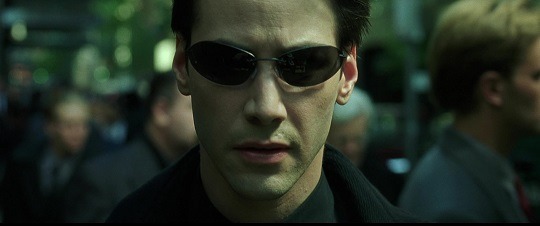
Cinemacon has passed and there has been a lot of awesome sh*t revealed. On the top of that list, obviously, Spider-Man: Far From Home has me geeked to high heaven but there were a ton of other noteworthy reveals. There was some Batman reveals, a few Mission Impossible 7 and Top Gun 2 trailers, plus audiences ever got a surprise screening of Ghostbusters: Afterlife. Now, that would be great on it's own but cats even got a little sizzle real for Matrix Resurrections: The long gestating fourth Matrix film. Apparently, this thing is releasing in December. I am lukewarm at best. I have fond memories of the Matrix trilogy as a whole but, since it’s final release some twenty years ago, the Wachowskis have been revealed to be one trick ponies. They kind of suck at film making. I mean, i liked Speed Racer but i just generally enjoy Speed Racer. It helped tremendously that Christina Ricci was Trixie, too, but everything after that was kind of balls. I also really like V for Vendetta but that’s not real their movie, they just adapted it. I guess you can say that about Speed Racer, too. Anyway, in light of there near Shyamalan-esque track record with their films, i wanted to revisit the first three Matrix films and see if they hold up, to try and muster some sense of excitement for what comes next.
The Matrix

Of the trilogy, this is easily the best film. Everything about it is exceptional. The Matrix was a whole ass shift in the cultural zeitgeist. It was a lot of people’s first experience with accessible cyberpunk and I'll always love it for that. I’ll also love it for normalizing Hong Kong style action sequences and giving us the most breathtaking application of Bullet Time I've seen to date. The Matrix s why the theater exists. If you’ve never seen this thing on the big screen, you missed out on something very special. I had just just turned thirteen when it released and checked it out at the dollar theater. I had only ever seen anything like this, in anime. Seeing all of my favorite Eighties OVAs filtered through the big budget Hollywood lens was incredible. I even like the rather pedestrian narrative. I think the story worked for what the movie was trying to do. It’s a shame the Wachowskis have tried to rewrite history about the narrative as of late. I understand the underlying themes of identity and sexuality but come on? That’s some college film theory bullsh*t that got tacked on after the fact. Now, if the original script is to be believed, then, yes, all of that, but what we got is not so profound. This is a basic Chosen One narrative with Dope ass effects that were ahead of it’s time.
A fr as the cast, what can i say? These motherf*ckers were perfect. Keanu Reeves as Neo was inspired. It’s wild to say that because dude is a plank but it works. He’s the POV character, he’s who you see that world through. Making him a blank slate so to speak, helps with immersion and that is a world you definitely wan to be immersed within. This was my first experience with Carrie-Ann Moss and I've loved her ever since. Her Trinity fast became one of my favorite characters and I'm actually pretty excited to see where she is in the new film. Lawrence Fishburne as Morpheus was an interesting choice. I wasn’t mad and it worked perfectly but it was weird seeing him in such an active, action oriented, role. That said, for me, this movie is made by Hugo Weaving. He is absolutely monstrous as Agent Smith. He’s got this scene chewing energy that mirrors Christoph Waltz’s Hans Landa and we all know how much i love that Nazi f*ck so that’s really high praise. To this day, I've got his Humanity is a Virus speech memorized. It was just that f*cking good! The Matrix is an exquisite watch and it is absolutely mandatory viewing if you consider yourself a fan of cinema.
The Matrix Reloaded
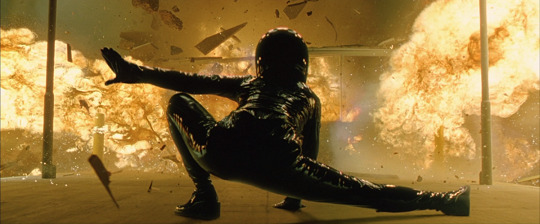
Whoo, boy, talk about a drop in quality. Reloaded released four years later in 2003 and it screams Studio Mandate. I was a sprightly eighteen years old when this thing dropped and made it a point to see it opening day. I really enjoyed the first outing so i figured this one would be just as amazing. Indeed, i remember leaving the theater thinking to myself how decent of a sequel it turned out to be. It wasn’t better than the first but it didn’t sh*t the bed like most follow-ups do. Fast forward to present day and, after watching this thing again for the first time in probably fifteen years, it’s kind of f*cking bad. Like, as a cinematic experience, it’s pretty tight Everything is amped up. Tons more action, way more bombastic set pieces, stakes have been raised considerably; The Matrix Reloaded is everything you want in a summer blockbuster sequel. However, that’s it. Everything else is worse. The acting has become way too hammy and the new cast members fit into this narrative like a square peg in a round hole. Why is f*cking Niobe even in this thing? Who even is the Merovingian? Why is Mouse? The pacing is all over the place, too. Like, this thing stops dead in it’s tracks on several occasions but that’s not the worst of it.
The worst thing is the narrative. What the f*ck even is the story trying to be told in this movie? It doesn’t make any f*cking sense. The Matrix was, very obviously, a standalone film. That was a closed narrative. Neo’s story had been told. Everything after that is unnecessary. This movie is an exercise in the unnecessary. I appreciate all of how unchained and manic Smith is in this but, outside of that, what the f*ck was the point of this whole narrative? It’s filler. This movie is filler and it feels like it. The returning cast is serviceable and seeing Zion was interesting. I like how all the survivors are just sweaty black people. I literally hated everyone added to the cast though. Well, that’s not quite true. I rather enjoyed Collin Chou as Seraph. Dude was inconsequential but i love seeing Asian martial artists not name Li or Chan getting some shine. Also, Monica Bellucci is in this and i kind of just love her in general. Her Persephone is absolutely disposable but she looks damn fine in that plastic wrapped dress of hers. I literally can’t be bothered mentioning anyone else. They are that forgettable. This movie is that forgettable. And it’s arguably the best of the two sequels.
The Matrix Revolutions
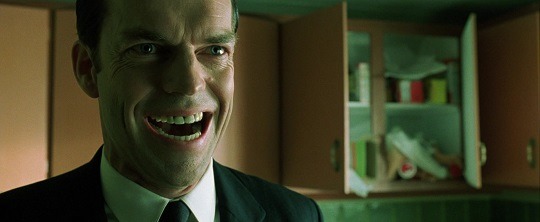
Talk about going out with a thud. Man, i saw this with my best friend, rest in peace B, and we both hated it. He was an even bigger fan of The Matrix than i was so his disappointment was palpable. I’ll never forget his visceral reaction when that rainbow spread across the super happy Hollywood ending. Dude was hot and he had every right to be. The first Matrix set up this intriguing, immersive, world full of fanatic visuals, great piratical stunts, and a very through provoking premise. The second Matrix was your basic Hollywood sequel; More shine, less substance. But Revolutions? Man this is peak Wachowski fail. You saw hints of this messiah sh*t in the first, it’s literally a Chosen One narrative, but thy went all in on that sh*t in Reloaded. By the time Revolutions finished, this whole narrative was so far up it’s own ass, it didn’t know which way was up. It just f*cking ends. Everyone is dead and it’s over. The Wachowskis went heavy on the Jesus imagery, they were not subtle, and the f*cking conflict just ends. Robot don’t stop using people as batteries. Flesh and blood Humans still have to live in Zion. The only thing that’s changed is Neo’s dead and Agent Smith has been deleted. That’s it. The Matrix still exists, people are still trapped in it, and everything that happened in these films doesn’t f*cking matter. Literally right back at the start of the whole goddamn conflict. Revolutions is so f*cking disappointing, dude, by every measure of that metric.
Hugh Weaving is still pretty good as Smith and Keanu does his best imitation of white bread as Neo but, like, everything else is just so pedestrian. Plus, this thing is long. Like, unreasonably so. Why the f*ck is this movie two hours? The entire trilogy is kind of like that but it’s most egregious in this one. This story could be told in ninety minutes, just like Reloaded. Why the f*ck do i have an extra half hour of bullsh*t in this? Like, that whole “Neo Lost” arc was unnecessary, in both sequels. F*cking why? I don’t hate Revolutions. It’s not a “bad” film per say, it’s just disappointing. It’s the poster child for the law of diminishing returns. The Matrix Revolutions is the what happens when you let creatives with fresh egos, run amok with one hundred and fifty million f*cking dollars. So much spectacle but even less substance that Reloaded and that motherf*cker was a hollow mess. Still, The Matrix Revolutions is better than anything Michael Bay or Zack Snyder has ever made so i guess it’s got that going for it.

#The Matrix#The Matrix Reloaded#The Matrix Revolutions#The Matrix Trilogy#Smokey brand Retrospective#Keeanu Reeves#Carrie-Anne Moss#Hugo Weaving#Lawrence Fishburne
3 notes
·
View notes
Text
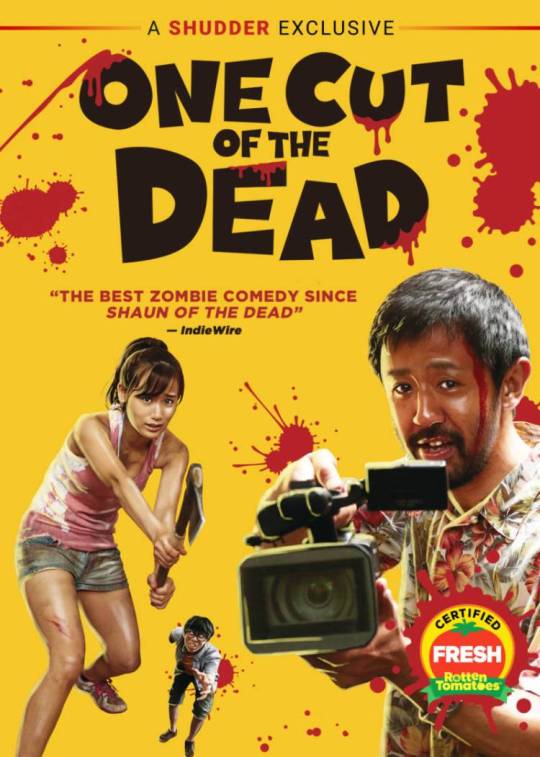
One Cut of the Dead (2017)
Spoiler Alert. I have never made the claim that this is a spoiler free film blog. I barely consider this a collection of film reviews as much as it is a space for me to have a one sided conversation about movies. I don't want to limit myself to the constraints of spoiler free content, for one because I believe in most cases we don't watch films to be surprised. I read many books, and many of those books have been adapted into films, and never once has knowing what is going to happen ruined my experience of a film. In regards to One Cut of the Dead however, I think you owe it to yourself to stop reading right here and go and see this film for yourself. I'm going to get the letter grade out of the way right now and let you know without any context that One Cut of the Dead get's an A from Reverend Chainsaw and the Cult of Cult. However, if you've already seen the movie and you would like to worship along with the Cult Film Tent Revival, please read on.
The Message
One Cut of the Dead is a two for one punch. First we are told the story of a film director who goes to extreme measures to create his zombie film. These extreme measures include shooting in a former testing facility and using an occult ritual to bring real zombies into the mix. The real zombies terrorize the actors and the crew as the mad director sporadically pops in and out shouting "Action". This almost 40 minute short film is of course done in one outstanding take. Due to all the running and chasing if you are a fan of butts more than faces, you will have a pleasant time. Still, this short film is off, there are strange lags where characters jump up from off screen for one reason or another, points where the camera drops and points at the ground, or where long drawn out conversations occur or the action just suddenly stops for an unexplained reason. What could possibly be happening?
Well, this is why when the credits roll early on in the feature you should stay tuned. You see our One Cut meta film, is actually a film within a film. Every thing that can go wrong will go wrong. Higurashi is a small time director living in Japan who specializes in small projects. One day he is scouted by the Zombie channel that is looking to launch it's premier with a very special project. Impressed with Higurashi's signature style "cheap but average", they propose that he be their man. The Zombie Channel wants to do a LIVE ONE TAKE thirty minute short film. After initially taking a moment to realize this insane idea is no joke, Higurashi agrees.
The filming takes way. The cast is difficult, the crew is barely manageable, and Higurashi and his wife are forced by their strange circumstances to take prominent roles in the chaotic picture. Equipment breaks down, improvisations are required, and there is no time for bathroom breaks. "One Cut of the Dead" proves a bizarre testing ground for our likeable rogues and they somehow manage against all odds to pull it off, explaining every quirk and oddity in the short films run time.
Please, please treat yourself and join me in receiving The Benediction.
Best Aspect: All is Revealed
One Cut of the Dead is so frustrating that it's brilliant, and so brilliant that it is frustrating. I want to know so badly if the film we see in the first half, is actually made up of footage that was being shot by the cast as the second half was being filmed, as opposed to being shot like a traditional movie. If so, It would add yet a third level of beautiful meta narrative to this movie.
What is particularly brilliant is that it does not sell itself as a film about film making, but as a much easier film where "it turns out the monsters are real", spoopy doopy stuff. Once you go in expecting that and you see all this surreal amateur stuff happening it keeps you intrigued. Why is the zombie pausing, why did those legs just appear on screen and walk off? Your left wondering what is happening and then the credits roll and the second part of the movie begins.
The second half is hilarious and it's so fun as you have each little mystery resolved and it's never boring but almost always mundane. This is not a horror movie, well it does contain a horror movie, but this is a love letter to all those happy accidents. I particularly love Evil Dead and the Texas Chainsaw Massacre, a love that is fueled by the chaotic stories that happened behind the scenes. It may be scripted, but One Cut of the Dead gives me all the satisfaction of watching a low budget horror romp, immediately followed by it's charming creation myth.
Worst Aspect: A Hat wearing a Hat
That said, it's strength is also a weakness. It is hard to write about, it's hard to always keep your head straight. This movie is a movie about making a movie about making a movie, it also is contains the movie about making a movie. Are you lost? No? Maybe I'm just dumb. It helps to not try to hard to explain it. And it only takes a little time to keep it all straight, but then again that's asking way more of the audience than most films do. Personally, it's barely even a problem, but that just speaks to how freaking great One Cut of the Dead is.
Best Character: In on the ACTION!
There is not a single character in One Cut of the Dead that is unlikeable, I almost did not give this movie a best character. However after a little bit of thinking I came down to Higurashi or Nao. Oh how I love you Nao, you crazy wild thing. But when it comes down to just candid hopefulness, and a hero that you root for the whole movie, Higurashi is the man. Every time he solves a problem and smiles it just warms my heart. I keep watching to see Higurashi succeed and anxiously anticipate his failure. The satisfaction the audience feels at the completion of this film hinges entirely on whether you want Higurashi to accomplish his herculean task.
Most WTF Moment: POOP!
I'm not even going to explain this one. Just know that there is a line of dialogue that is simply "poop" and it'll get ya.
Most Memorable Shot: Ritual Site
In lieu of a Best Kill category or another Worst category (which is hard to come up with in regards to One Cut), I'd invented the Most Memorable Shot category. It's not the same as a scene because in my minds eye I'm not thinking of a whole sequence. if I were I'd have to give it to the titular one cut. What I mean is a solid shot that sticks with me when I close my eyes and think about this film. And at the conclusion of the film within a film our lead actress is clutching a knife, facing the camera that is staring down at her, and at her feet is a massive pentagram made of blood. It's a really cool image and if you've seen the movie you know how much Higurashi and the crew worked to get that specific image in your mind. You could say out of all the visuals in this movie the pentagram shot is the top of the pyramid.
Summary
Once Cut of the dead is so enjoyable I've watched it 3 times in 2 days. Every time I rewatch it I catch something else. My initial motivation was to see the first segment again with the thought of the second segment in mind, but I just couldn't stop there. This movie is candy. This movie is cocaine. If you love horror films for the artistry (or lack there of) and not just for the scares, then this movie will hit many sweet spots for you. Don't sleep on this. Get a Shudder subscription and watch One Cut of the Dead, and then watch it again.
Overall Grade: A
#A#Grade A#Grade: A#Once Cut of The Dead#Japan#Japanese#Comedy#horror film#mockumentary#zombie#horror comedy#2017#2010s#(A)
2 notes
·
View notes
Text
Top 10 CSatM Episodes (1/2)
Ahhh, Captain Scarlet and the Mysterons...! Probably only Second to Thunderbirds when it comes to the most popular and beloved Supermarination programme, with only Stingray able to compete for that coveted Silver Medal. But for me, it’s my Favourite!
I could go on and on about it, but for now I’ll go over my personal picks for a Top 10, which may give some insight into what about the way the series ticks makes it so enthralling.
Without further ado, let’s jump in! I’m not ordering them by preference, but rather the Episode order as I watched them on my DVDs (tediously the ep listings never seem to be consistent :T) Spoilers for all eps covered! ✂
Winged Assassin

Starting off my Favourites is the 2nd episode of the whole show, featuring a good condensed version of the events of Ep 1 if ya missed it and probably the best explanation on the workings of Retrometabolism that canon media is ever gonna grant us. The plot is fairly straightforward, but what elevates this is the aforementioned Exposition, which feels more organic than it did last episode, the interactions between Scarlet and Blue, and even the shocking twist at the ending, where the mission that had been going so well falls at the very last hurdle, in spite of Spectrum’s best efforts.
One of the most chilling visuals in the series is a surfaced shard of a downed passenger plane floating up from the sea, before the camera pans out to show the duplicated plane flying through the air, and another dark shot later on, of Scarlet’s limp hand with blood running down after he died in the effort to prevent the massive explosion that occurs regardless.
Winged Assassin sets a lot of standards of things to follow; traits like massive collateral damage just as part of the Mysteron’s grander scheme, the close partnership of Scarlet and Blue, Scarlet’s seldom used Sixth Sense and even the occasional downer ending, where the Mysterons manage to sneak a victory in and actually kill or destroy their stated target.
White as Snow
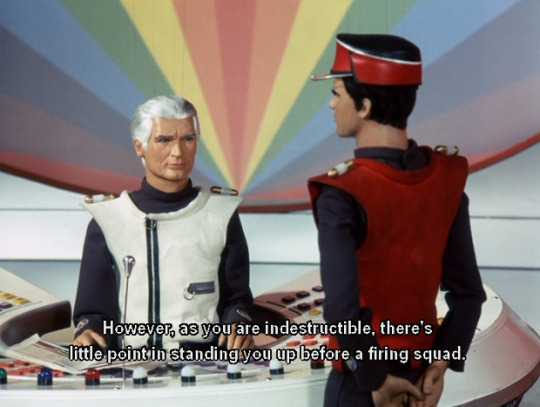
This episode shines a very interesting light on the dynamics between Col. White and Scarlet. It’s obviously one of a superior giving orders most of the time, but in a twist from the somewhat strict nature of Jeff Tracy over his sons who show respect to their father by not arguing back, with these two there’s actually the occassional spark of friction, that Scarlet will voice when he doesn’t like the commands and will only reluctantly go through the motions in the situation. I’m referring mostly to the first Mysteron attack, where a satellite is on a collision course with Cloudbase, but Scarlet unsubtly opposes the plan as there’s the possibility of innocent people on board who would get killed if Spectrum shot it down first. However, he’s overruled... and it turns out that it was indeed a trap, the people on board had been exploded hours ago and what was shot down was a Replicant copy. And that’s just the first half of the episode! But I find it interesting that again, back in Thunderbirds, the call to not remotely destroy something like that on the offchance it was populated would be the Correct course of action, but in this show pragmatism is needed, the needs of the many outweigh the needs of the few.
Anyway, the episode has another Mysteron attack aboard a submarine, with plenty of tension... but yet, there’s something of a comedic bend to the episode, such as a furious White shouting at the currently dead Scarlet, much to the Naval crew’s confusion, and the scene at the end which I’ve taken the picture from. The weakest part of the episode is probably Blue in charge of Cloudbase, as he doesn’t seem to know what he’s doing and I feel they coulda done more with him. Oh well! At least we got the fantastic music insert, which is also titled White as Snow.
Operation Time
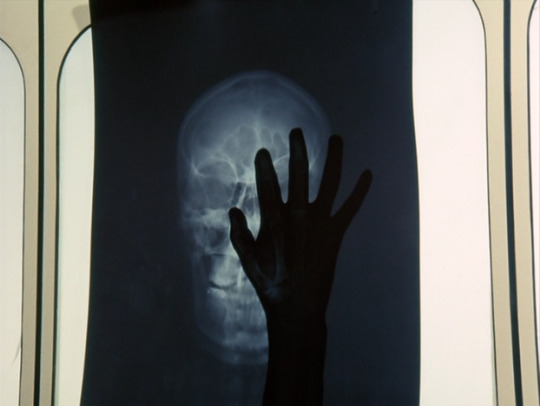
Probably ranking in my Top 3, Operation Time is pretty remarkably both one of the most tension filled... yet an extremely funny episode. I guess some of that’s just due to my own odd sense of humour, though some moments are clearly intentional. Both the operation scenes, the Mysteron’s pursuit of the Doctor, and finally Spectrum chasing the Mysteron!Doctor are all played very suspensefully, and I find myself holding my breath. But then the funny scenes, like everything with Magenta and how hilariously pissy and unsubtle the Fake!Doctor gets leave me in stitches! [pun unintended lol]
I dunno, maybe some of the amusement effect is enhanced by the strong contrast between the scenes. Also we get a very grisly death for the Fake!Doctor and this episode establishes weaknesses for the Mysterons that will come up in future instalments. There’s a lot this ep has to offer, even something of an insight into 60′s medicine (though the series is set in 2068). While an extremely minor point, both the scenes with operations have the pssssshh.....fsssssshhhh sound that I associate with ventilators even though they ain’t being used, what’s up with that? But it’s another thing to add to the Atmosphere so s’all good, man.
Odd that I can’t think of much else to put here, I love it so much but maybe it’s so solid in the couple of things it does that’s all there really is to say? I’m feeling frustrated at how I don’t seem to have written enough for it, but trust me when I say it’s excellent and that it’s absolutely a Must Watch if you’re giving the series a look. (Though again, I’m spoiling each ep covered so uhh... read at your own risk if you’re using this to judge it!)
The Heart of New York

An interesting tale that I’ve actually Heard more than I’ve watched, as the audio adaptation is a free sample on the official Gerry Anderson site! [At least at the time of writing lmao, it’s worth a look anyway. This message was not paid for.]
This story is somewhat unique in that the Mysterons’ plan is pretty tame by their standards. They want to blow up... a Bank. Sure, it contributes to the long game they play, causing disruption and destruction, but compared to the casual massive collateral damage they inflict as part of a more focused murder attempt (again, see Winged Assassin and the passenger plane) this is small potatoes. But still, they end up feeling more moral in this episode than the actual ne’er do wells, a trio of would-be Robbers. These guys are pretty assholish, deliberately using the horrible cosmic war that’s already taken lives in the triple digits to hide behind while they take their pickings from a vault. Captain Black locking these morons in with the explosives feels like poetic justice, that they really did get what they wanted and are punished in kind.
Maybe this feeds the Mysteron’s point, that humans are aggressive, corrupt and selfish... though Colonel White challenges this view at the end of the episode, stating the robbers aren’t indicative of humanity as a whole. The whole shebang is a lot like The Twilight Zone, honestly. All we need is Rod Serling to open and close the episode...
Point 783

This episode is a bit harder to go into depth on, to be honest, it’s not one with a particular gimmic that makes it more memorable, but it’s a very solid ep all the same. There’s still a fair few layers that keep me thinking, like how it seems one of the Methane Trunk drivers had seemingly been Mysterionised offscreen to enable the Mysteron’s main pawns to me made. Then the first attempt to kill the Supreme Commander is thwarted by Scarlet’s (somewhat inconsistant) Mysteron Sense and perspex tubes that take their sweet time to descend and don’t even prioritise the actual target lol
Anyway, the meat of the episode is focused on the guest vehicle, the Unitron implacable unmanned Tank that can be controlled remotely by human operator or programmed to destroy something particular, and it will not stop or slow down no matter what’s thrown at it. Something something Proto-Drone Warfare commentary. The Mysterons’ last big attempt to assassinate today’s dude has one of their Mysterionised guys from earlier become the target, unknown to everyone else until he draws his gun inside the SPV (who even points out the 6th sense didn’t activate!). Scarlet gets shot 3 times but manages to eject himself and the Supreme Commander, which leads to the above scene, which offers a nice, human response.
Mr Supreme Commander later chews Blue out as it emerges instead of Scarlet going to a Hospital within 10 minutes, Spectrum insisted on waiting for one of their Helicopters to pick him up, which took 3 hours. Poor Blue has to try reassuring the army guys that Scarlet will be fine, truuuuust hiiiim. It makes me wonder if Spectrum is making things easier or harder overall by keeping his Retrometabolism under their hats, though I can understand they’d have reservations, but just trying to gloss over it with a ‘no no, it’s fine, he’ll get better.’ type answer doesn’t seem all that convincing. But I enjoy that it’s semi challenged here. And this episode summary ended up longer than expected cause all the Thinking I’ve done, haha!
=======
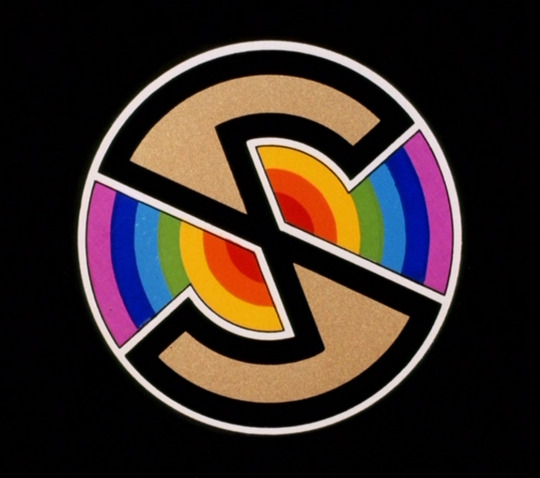
This has gotten a lot longer than expected and will be Two Parts! Find the second half here~
1 note
·
View note
Text
Movie Meme
Took me a bit of time, but I was tagged by @bunnikkila to list my nine favorite movies, and since I can’t help but be ridiculously verbose about that very topic, you can see them all under the cut 8D
As for who I tag? Well, as always with the caveat that you are free to ignore if you don’t wanna, I’ll go with: @elistodragonwings @kaikaku @donnys-boy @robotnik-mun @sally-mun @fini-mun @werewolf-t33th @cviperfan and @wildwoodmage
and don’t worry, if you DO go for it, you don’t have to get as Extra as I did about it XD
9.)
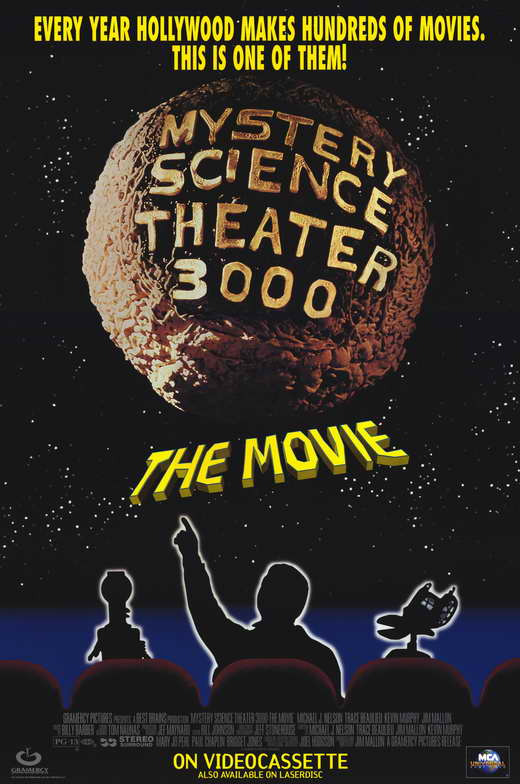
Look, the meme is about Favorite Movies, not necessarily the BEST Movies, OK? And for the most part this list consists of films where that division is less meaningful in terms of how I evaluate the other movies on here. But in this specific case, “Mystery Science Theater 3000: The Movie”, which is ultimately not all that different from the “Mystery Science Theater 3000″ TV show it spun off from and thus not particularly impressive as a work of Cinema Qua Cinema, makes the cut primarily because it’s a movie I know so well and have enjoyed so often that I can practically recite the whole thing to you by rote; I quote it all the time in my day-to-day life, I think about it often when I need a little smile, and it’s also become my favorite tool for introducing newcomers to MST3K as a whole since it was designed with a slightly broader audience in mind than the more willfully-eclectic series. And given how much I love MST3K As A Whole, that’s an especially strong factor in its favor.
8.)

Looky looky, @bunnikkila, we (unsurprisingly) have a pick in common! I’m sure this is the one and only time THAT’S going to happen on this list. 8D
Y’know, nearly thirty years (and one fairly useless remake >_>) later, I think the thing that impresses me about “The Lion King” is just how much it is still able to grab me emotionally. Some of that is unquestionably tied up with how strongly I associate this movie with my family, all of whom it became very special to as a Shared Experience. But I also don’t know of a lot of people who haven’t had that same emotional experience with it, and that to me suggests there’s more going on here than just Nostalgia. The mixture of Shakesperean plotting with Disney’s signature strength of Character, for one thing, granting the movie’s story an Epic Scope that never forgets the emotional inner lives of its cast. The music for another, not only its instantly-iconic song-book but also its memorable score, armed with both Big Bombast and Gentle Sentiment. And the unforgettably gorgeous animation, rendering every last element of its world with believable naturalism and strongly-defined personality. All of it, together, makes for what I still personally consider the Crowning Achievement of the Disney Renaissance.
7.)

I think, if I had to name the thing I find most lacking in far too many modern Action Movies, it’s Clarity. They all tend to lard their plots up with a bunch of unnecessary contrivances and complications in hopes of making themselves appear more clever than they actually are, and all it usually does is just dilute the impact of the whole thing. “Mad Max: Fury Road”, by contrast, is all about Clarity. I could sum up literally its entire plot in a paragraph if I wanted, because it is basically One Big Chase Scene from start to finish, never really deviating from that structure for more than a few minutes at a time. And that, combined with its exceptionally well-crafted Action Sequences, means that the full weight of its visceral power hits you full force every time. But don’t be fooled; that simplicity is not to be mistaken for shallowness. Indeed, precisely by getting out of its own way, knowing exactly what it wants to do and why, “Fury Road” also delivers a story that is, in spite of what you might guess, genuinely subtle and smart. Every character is immediately unforgettable and compelling because their role in the story is so well-considered and their personalities all so stark. The world it crafts feels at once fascinatingly surreal and yet All Too Real at the same time because even its most Fantastic elements are ultimately just grotesque reflections of things the audience knows only too well. And most of all, it tells a story with real, meaningful Themes that are deeply woven into each of its individual elements, such that the whole thing is deeply satisfying emotionally, but also piercingly Relevant in all the best, most affecting ways.
6.)
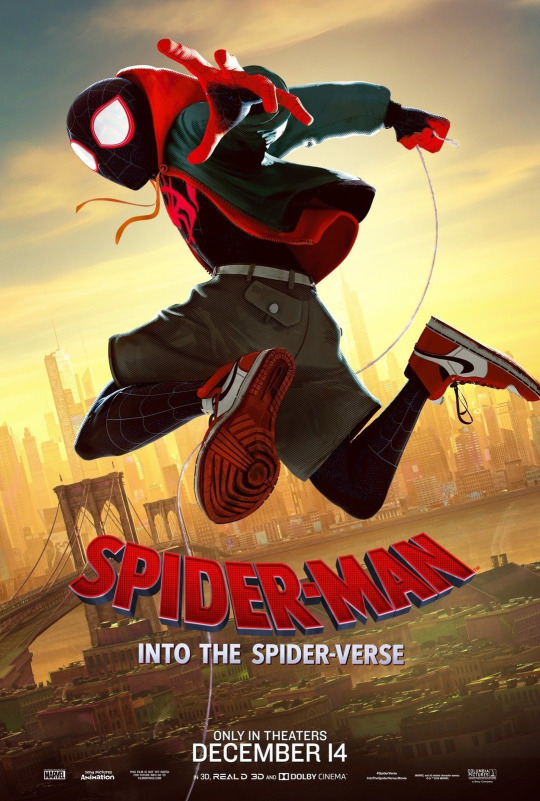
Oh look, another pick I have in common with @bunnikkila! This must be the last one, right?
But yeah, this is just a legitimately great movie, at every level, in every way. Stylistically, it is one of the most radically inventive things to have ever been made in the world of Western Animated Movies, gleefully mixing together a vast array of Aesthetics and Techniques that are at once viscerally distinct and yet coherently connected, all rendered with a fantastic eye toward the world of Comic Book Visual Language that keeps finding new and extremely fun ways to play with that instantly-recognizable iconography. For that alone, I would call it one of the greatest triumphs of 21st century animation. But then, on top of that, the story it tells is one that is simultaneously Arch and self-aware, delivering some of the most fantastically hilarious punch-lines imaginable more than a few of which are at the expense of the very franchise it is working within...but also entirely earnest, sincere, and emotionally affecting. It is, at once, a movie that manages to be about The Idea Of Spider-Man in its totality while also being about just one kid coming to grips with who he is, what he can do, and what his life can be. I don’t know that I can remember the last time a movie so immediately and unmistakably marked itself as an Enduring Masterpiece, but “Into the Spider-Verse” absolutely pulled it off.
5.)

Ordinarily, I would cheat and give this slot to the “Lord of the Rings” trilogy in its totality. But somehow, the fact that this is about “FAVORITE” movies instead of just what we think the BEST one is compels me to narrow it down to just one. And if I had to pick just one, it would be the first of the three, “Fellowship of the Ring”. It’s not necessarily anything that the other two movies get wrong, either. All three of the LotR movies possess many of its keenest strengths, after all. For a starter, there’s the keen understanding of how best to adapt the source material without being enslaved to it; capturing many of its most iconic moments while cleverly tweaking elements to make them more cinematic, knowing what scenes to focus on for the sake of more clearly focusing the emotional through-lines of the story, and knowing what scenes, no matter how good on the page, ultimately don’t fit to the shape the adaptation has taken. There’s also its pitch-perfect casting, each and every actor doing a fantastic job of embodying the characters so well that even as your personal vision of them from the books may differ radically from what is on-screen, they nonetheless end up feeling Right for the part and a strong, compelling presence. And there’s the deft visual hand of director Peter Jackson, who knows exactly how to craft a Middle Earth that feels at once lived-in and real but also Fantastic and magical. “Fellowship”, for me at least, thus wins out mostly because it has the good luck of being adapted from the strongest of the three books, the point at which the narrative is at its most unified and thus has the strongest overall momentum. But also because so few movies have so swept me away with the sense of stepping into a world I have always dreamed of in my mind’s eye, and that’s the sort of thing that can only happen at the beginning of a journey.
4.)
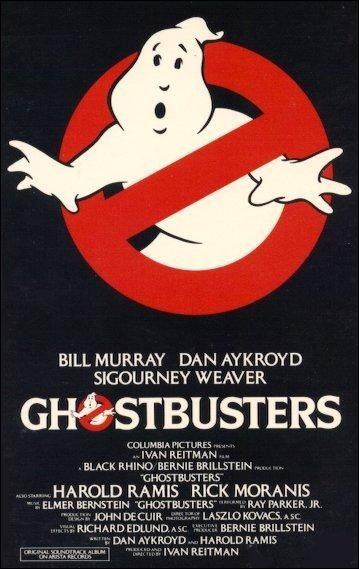
Now here’s a movie that is literally sown in to my very being. It’s the last movie my mother saw in theaters before becoming a Mom. I grew up watching the “Real Ghostbusters” cartoon all the time and playing with the attendant toys; I had a “Ghostbusters” Birthday Party when I was, like, four years old. It has been my annual Halloween Tradition to get myself a big Cheese Pizza and watch this movie for about as long as I’ve had disposable income to myself. There is, quite literally, no point in my life where I don’t remember “Ghostbusters” being a fixture in it. And as a nice bonus? It is, legitimately, a Genuinely Great Movie. I realize that isn’t quite as universally agreed upon these days as it was even a few years ago (thanks, Literally The Worst Kind Of Virulently Misogynist Assholes lD; ), but I still feel pretty confident in saying this one really is That Good. I still find basically every one of its jokes hilarious; even now I could quote just about any one of them and get a laugh. I still find its central premise, What If Exorcism Was A Blue-Collar Business, a brilliant, almost subversively clever one that takes The Supernatural out of the realm of The Unknowable and into a world where even you, an ordinary person off the street, can in fact fight back against it. I still think it’s one of the all-time great examples of how to balance Tone in this sort of High Concept Genre Bender, by allowing The Story to be played relatively straight while allowing the comedy to flow naturally from the characters’ reactions to that story, allowing its Ghostly aspects to land as Genuinely Scary (or at least Worth Taking Seriously) without getting too Stern and Serious about it. And I still listen to that unforgettable Title Song all the time! So yeah, even if I could be more objective about it, “Ghostbusters” would almost certainly make this cut.
3.)
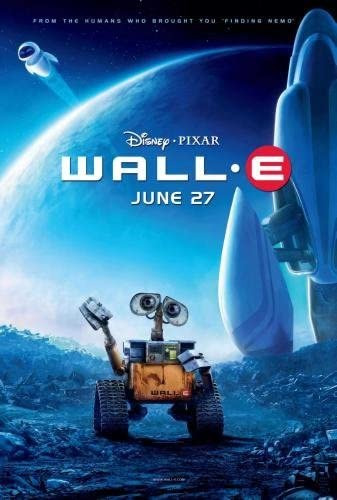
And so we come to the third and last pick I have in common with @bunnikkila, not coincidentally a movie that played a key role in solidifying our friendship, as bonding over our shared love of it was a big part of how we got to know each other on deviantART waaaay back in the day <3
By 2008, I really didn’t think it was possible for a movie or comic or TV show to really become “part” of me anymore, the way things like Sonic the Hedgehog or Marvel Super Heroes or Some Other Movie Character Who Might Be At The Top Of This List had. And then “WALL-E” came along and proved that to be completely, utterly wrong. I didn’t just love this movie, I was inspired by it, to a degree of strength and consistency that I’m still not entirely sure has yet been matched. And to be sure, some of that is undoubtedly because the movie had already basically won the war before I’d even bought my ticket; Adorable Robots In Love is something like My Platonic Storytelling Ideal, after all. But even setting that aside, “WALL-E” is a movie where even now I can’t help but be keenly aware, and gently awed, at the beauty of its craft; indeed, watching this movie in a theater did a lot to make me better understand why movies work on us the way they do, because I left that theater chewing so much on every last one of its elements. Its gorgeous animation, the way it conveys Character through Actions more so than language, the dream-like quality of its musical score (even as i type this i get teary thinking about certain motifs), the clear and meaningful way it builds its theme and story together so harmoniously, and the particular perspective it takes on our relationships with each other, with our environments, and with our own technology...all of it speaks to me deeply and profoundly, and it’s no coincidence that I have seen this movie more times in theaters than any other on this list (twelve times, for the record, and I still remember each and every time XD).
2.)

This one needs no personal qualifications, to my mind. Yes, I have some degree of nostalgic attachment to it for having seen it relatively young with my brothers and being deeply moved by it then, but it’s not at all like the kind of Nostalgia I have for “The Lion King”. “Princess Mononoke” is just flat-out, full-stop a complete Masterpiece, not just my personal pick for one of the single-best animated films ever made, but one of the best films period. It’s almost difficult for me to put into words how great this movie is, certainly in a way that hasn’t been repeated to death by thousands of other smarter people, because no one of its elements quite answers the question of why it is so great, to my mind. Yes, the animation is absolutely gorgeous with a design sensibility that brings Ancient Mythology to life so vividly that its influence can still be felt today (The Forest Spirit alone has been homaged all over the place). And yes, the music is hauntingly beautiful, at once capturing the gentle rhythm of nature but also the elegiac tone of Life Moving On. And yes, the story is an incredible mixture of the Broad Mythic Strokes of an Ancient Legend grounded in all too human Emotions and Ideas about the balance of nature, the full meaning and cost of Warfare, and perhaps most important of all, about how we determine Right and Wrong when everyone involved in a conflict is fighting simply for the right to survive. But all of those things add up together to something even greater than a simple sum, because each one isn’t just good in its own right but because each element so perfectly reinforces the other. And even having said all that? I really could just carry on singing this movie’s praises. Just...an absolute masterpiece, top to bottom.
1.)
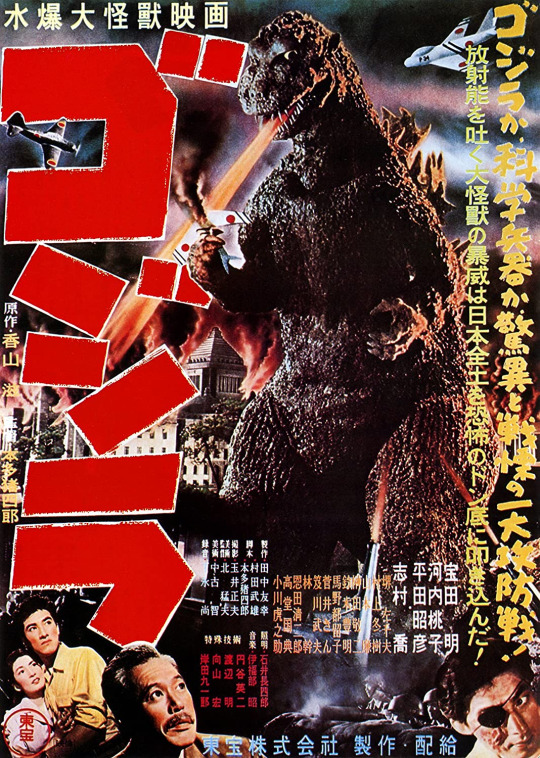
I don’t imagine any of you are terribly surprised at this, right? I almost feel like it’d be redundant to explain my love for this movie, given how self-obvious I imagine it is to basically everyone who knows me Literally At All. But heck, I’ve rambled on this long, why not go all the way? Because the thing of it is, “Gojira” (to be clear, the original Japanese movie from 1954 rather than its American edit, “Godzilla: King of the Monsters” from 1956) doesn’t just top the list by being a Great Movie. Though to be clear, it really is. Flawless? No; there’s a reliance on puppetry that even for the time can be a bit chintzier than the movie can really afford, in particular. But brilliant, even so, a heart-wrenching example of Science Fiction Storytelling As Allegory, one that, in a rarity not just for its own genre but indeed for many movies in general, very meaningfully lingers on its deepest, darkest implications. Many a film critic has pointed it out, and it remains true: the stark black-and-white photography heightens the sense of Implacable Horror at the core of the story, and the way the central Melodrama, a tragic love triangle that carries with it many aspects of Class Conflict and Personal Desire VS. The Collective Good, ties back into the main story is truly beautiful in its elegance and emotional impact. Still, for me personally, it tops the list, now and always, because it is a movie that affirmed something for me, that the character I had fallen in love with as a child convincing his family to watch a monster movie with him on television to prove his seven-year-old bravery, really was as genuinely as powerful and meaningful a figure as I had always imagined him to be.
3 notes
·
View notes
Text
All-Star Superman #2
A scant year to the day since part 1!
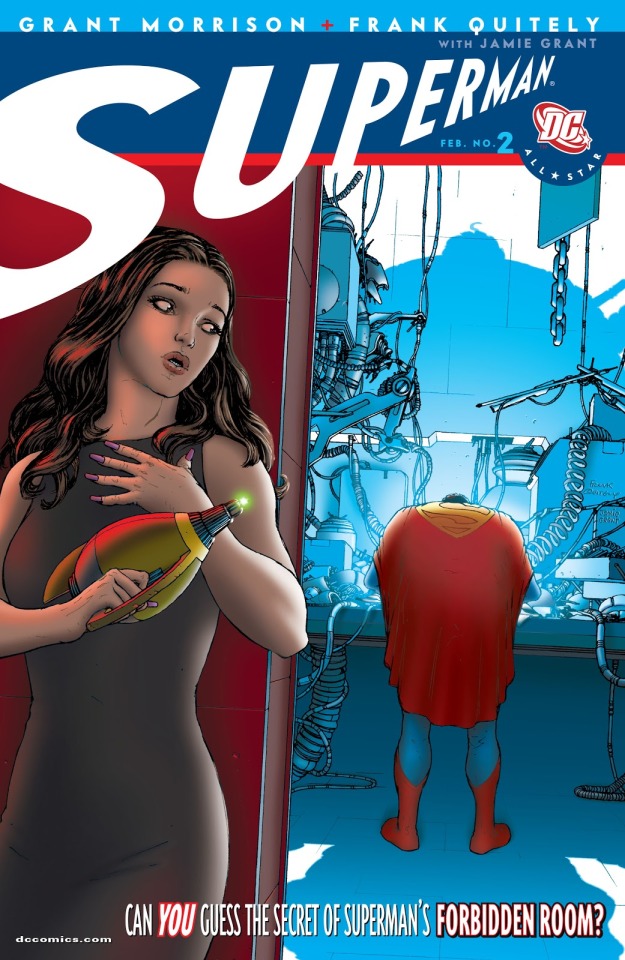
All evidence to the contrary I actually have always wanted to go back to this, especially since I keep getting asked if I’ll do so and it stirs my omnipresent sense of guilt over my lack of productivity, and also the last year has not resulted in a mass turnaround of people realizing it’s a for-real good book and not just comfort food so this remains necessary. This isn’t going to be quite as in-depth as the first go-around - both that as the introductory issue and that as the introductory recap had a lot of groundwork to lay - but still plenty to cover, as this issue sets up Lois and Superman’s arcs for the series, which is rooted (amazingly, especially right off the bat, given the book’s reputation of being about how amazing Superman is) in how badly Superman’s let his fears and shortsightedness poison the most important relationship in his life.
If the first issue is the big classic Superman material - Superman saving the day from the monster! Lois and Clark and the rest of the Daily Planet crew! Lex Luthor’s sinister schemes! A ticking clock to doom! - this scales all the way down to the uncomfortably, stiflingly intimate. Classic archetypal Superman stuff gives way to the most Silver Age issue: casual huge ideas, relationship drama, misunderstandings, last-minute reveals that recontextualize the entire issue, and baaaarely latent psychodrama bubbling up at the edges. In service of that the visual framing here is not unlike a stage play, a limited set of physically connected locales as a pair of figures bounce off one another. Quitely and Grant’s work is therefore comparatively subdued next to issue #1, keeping to traditional panel layouts and wide or medium shots with a background color palate of mostly blacks and whites and grays with a handful of other colors popping out...until Lois starts to lose her shit at the end of the issue and we get close-ups and full black and white panels and eerie glowing and dutch angles and that unsettling abstract image of her clenched teeth, as the story starts to squeeze us like Lois’s gut.
She’s right to be unsettled for that matter; she’s alone on Superman’s turf (the one issue where that’s the case other than #6, and that one’s about how Smallville stopped being his home), the weird antiseptic alien lair of the ultimate super-hobbyist, and all the baggage of their relationship is spilling out into the open as she has less and less reason to think the best of this odd man who’s been lying to her for years. Unlike the Silver Age tales this is referencing, she’s absolutely on the money with her complaints about him: he’s been dicking around with her forever and thinks it can all be okay now (His little “What?” on the second page when she bursts his bubble says it all), and he’s awkwardly overcompensating trying to fix it.

While the Fortress tour serves to peacefully acclimate us to how utterly bizarre Superman’s world really gets past the traditional rescues (the little cubic starfield we don’t know the meaning of yet, trophies are floating rather than physically suspended, the glowing flowers in Lois’s room, “The Phantom Zone map room’s pretty dull unless you can see radio-negative anti-waves”), Superman himself is...humblebragging isn’t the right way of putting it, but it feels like he’s working way, way harder than he ever will again in this book to be cool and impressive and assuring. He’s a dope in love, but he can tell something’s up and that super-brain of his isn’t putting the obvious pieces together, or noticing that this is just putting her off further and further until, like Bluebeard’s wife before her, she stumbles through the threshold of the door she was never meant to, even of course in the end he’s still Superman and there’s a perfectly good reason. Not a good enough reason, however, for her accusations at dinner to not hit home - his mind may be expanding, but he’s still way up his own ass here in a genuinely unpleasant way that’ll be elaborated on momentarily. For now he’s left stammering that she should trust him and it’s limp and phony, especially compared to his big entreaty for someone to trust him in #10 (which’ll be right after he finally comes clean with her); while Superman may not be considered a savior figure by his friends in here the way he often is in the mainline comics Lois seems to be the only one who doesn’t look up to him at least a little bit, but that clarity means she’ll call him out where no one else will.
Across the next two pages it’s all laid out, and we get to the roots of where things have gone wrong between the two of them. Lois is paranoid, certainly, the panels are literally squeezing in on her, but with Superman seeming so out-there and alien like never before she would have every right to be even sans alien chemicals. But notably there remains throughout a part of her assuming the best of him wondering if maybe this is just another big misunderstanding or that he’s simply been mutated by the solar overexposure. And in her heart of hearts, she admits that maybe she wants this to be another big damn trick with a completely sensible justification, because the alternative is that this is the new normal and she has to accept that he’s a flawed mortal man. It’s ugly and it’s mean - especially since she likes Clark - and it’s human as hell in the worst, most understandable way. It’s not going to be until said mortality is staring her in the face that she’ll be able to accept it.

Superman, meanwhile...someone could write a thesis on these panels as an articulation of the Superman/Clark dynamic. The Mirror of Truth is actually preexisting, centerpiece of a Jerry Siegel/Curt Swan joint in Action Comics #269 that was later adapted into the Superman newspaper strip where Lois uses it to figure out Superman is Clark Kent until he tricks her into believing the mirror can lie, after which he tosses it in a volcano; here it’s survived, and curiously shows him as Superman rather than Clark, when in the original tale it displayed Kent even though that was fully the era of Clark as a disguise. In here too it’s Superman who’s the ‘true’ identity of the two and which this time is reflected in the mirror, yet as in #1 it’s Clark who says what he’s truly feeling. In that light, the final panel of the abandoned glasses reads like nothing so much as Superman using the mirror as affirmation that the truth of the solemn, steadfast Superman identity gives him licence to deny the uncomfortable emotions his squishy human farmboy side is dredging up, ‘lying’ to him in a way he had to fake in the source material. Those emotions however knock right on the door of what he can’t grasp here: Clark’s so wrapped up in his own head trying to do the ‘right’ thing that he’s overlooking how his attempts at self-sacrificing selflessness are hurting the people around him. Throughout the series he’ll come to rely on others, first at his lowest points with Jimmy and the Bizarros, until at last he comes to invest true trust in Lois, and the Kandorians, and Leo Quintum, and even Lex.
For now though Lois is deep in a hole, a brief but memorable meeting with the Unknown Superman of 4500AD - everything Superman seems to be becoming to her even before she wonders if it’s literally him, cryptic and masked and with a big ‘ol question mark right on his chest instead of the familiar comforting logo, even his gutbuster of a question reinforcing his distance from a recognizable human experience - leading her all the way to reimagining her Silver Age ideal happy ending of marriage and family with Superman as a Cronenbergian horror. It’s still a Superman story, it turns out he had the very best reason possible for wanting to keep her in the dark, but right through to the end he remains just a little condescending in his reassurance, and his gift of essentially bringing her up to his ‘level’ isn’t going to solve the problem. While the next issue lets us see the two of them properly in love, it won’t be until the elephant in the room comes out that they can come to terms.
Additional notes
* God Quitely is so good. Look at the way the seatbelt curves in the first panel! Lois’s bemused little disbelieving smirk!
* Pages 2-3: Aurora Borealis?!
* Lois is the only character other than Superman who gets to have actual narration (in both cases as looks at their in-text writing), the only one whose viewpoint is thus privileged in the same way as his.
* The key is the realization of this series’ aesthetic in a nutshell: the old-school idea in a sleek, shiny, clever new way that doesn’t take away from the fantastical toyeticness of it all. For that matter, the key is the centerpiece of a later bit with Superman that could be fairly described as the long-term goal of the book book as Morrison’s hoped-for perennial: “One day some future man or woman will open that door, with that key. When they do, I want them to know how it felt to live at the dawn of the age of superheroes.”

* This is A. The first note of a larger DC universe existing offscreen, something that I’ll go into more when discussing #8, B. A brilliant, concise, fun little summation of his place in Superman’s world, and C. Absolutely hilarious given Morrison suggested in his exit interview that this could be seen as much later on in the same universe as All-Star Batman & Robin The Boy Wonder, which entirely rewrites the tone of that moment.
* Already discussed the key but the muscles in Superman’s hand tensing a bit at picking it up is another great detail.
* The glimpse of the Fortress here is excellent: the statues of his friends and enemies instead of pictures because he does things bigger with the yellow electric something crackling at the end of it, the off-model but curious-looking robot appearing to glance at Kandor (are it and the bigger robot with the seats on top of it trophies, or Superman Robots with different designs tasked for specific purposes?), the classic Bad Penny Good For One Crime, the Legion time bubble that establishes his time-traveling credentials for later, the Titanic where he and Lois will dine when their relationship hits a proverbial iceberg, and most strikingly the space shuttle Columbia, his apparent rescue of which I have to imagine is a reference to Astro City’s Superman analogue Samaritan debuting by averting the Challenger disaster.
* It’s next issue that has my actual favorite Superman/Lois moment of all time, but “When we’re married fifteen years, when I’m sagging and he looks just the same, will he still meet me and say things like...” “These are for you. I picked them on Alpha Centauri 4.” is right up there.
* The technological aesthetic of the Fortress is so different than P.R.O.J.E.C.T., sleek and solid and cleanly-lit and antiseptic, beautiful and advanced but a little cold in its own way. As stuffed with wonder as this place may be, there’s something hauntingly empty about it, suiting both the tone of the issue and as a physical embodiment of Superman’s emotional state. The one part that goes against it is the forbidden room, it even has beakers and test tubes to sell the mad scientist vibe...though if you were to stretch it, it much more close resembles the human technology seen at P.R.O.J.E.C.T., and this is meant as a gift for one.
* The cosmic anvil made it along with the key into the CWverse, Lois used it in Elseworlds! I may not be expecting All-Star quality from the upcoming Superman and Lois, but it’s good to know the powers that be are using it as a reference point (beyond how it inspired Supergirl’s take on Cat Grant, a connection I discussed in a post that seems to have vanished into thin air). The whole page is perfect, Superman at his most joyfully benign and beautiful and godlike; it’s the one bit where Lois’s skepticism cracks a touch watching him feed his adorable little Lovecraftian abomination from beyond the stars.
* While he never appears physically aside from a statue Brainiac hovers over this series from beginning to end in name and deed, the ominous ultimate enemy of Superman’s past, the great trial overcome even as the scars forever remain. Morrison mentioned in the exit interview that he didn’t appear in here because he and Quitely already used him as the villain of JLA: Earth 2, but that if he had it would have borrowed Superman: The Animated Series’ take on him as a Kryptonian AI gone rogue. Personally I like his place in here as-is, a little totem parallel to the Justice League references indicating the breadth of Superman’s history between putting on the cape and Luthor’s final scheme.
* A pair of minor notes: Lois points at Superman with the pointy fork when asking him pointed questions, and while it’s not immediately clear on first read she does in fact ask the Unknown Superman exactly 3 questions (“Kal Kent?” “Will Superman and I ever marry and have children?” “What do you mean?”) before he replies with his own, as promised.
* “Oww.” and “Tickles.” literally could not be more perfect Superman moments.
* Worth taking a moment to marvel at just how many future plot elements are seeded here. There’s the obvious bit of Superman thinking about having a partner setting up the next issue, but we also for issue #6 have our first look at Kal Kent and Lois wondering “What if (the Unknown Superman) was really (Superman)?” when Clark will indeed pose as him, for #10 we get our first look at Qwewq, and for #11 not only is the Sun-Eater introduced but so is Robot 7′s malfunction as a result of Luthor’s tampering.
* The structure of the series according to Morrison is a solar cycle, beginning and ending at midday with nightfall in the center. If last issue was the sun at its brightest we begin the descent here, with Superman remaining larger-than-life and ultimately trustworthy but with his classic persona and habits held to an additional, unflattering degree of scrutiny.
#All Star Superman#Superman#Lois Lane#Grant Morrison#Frank Quitely#Jamie Grant#Phil Balsman#Art#Silver Age#Clark Kent#Batman#All Star Batman & Robin the Boy Wonder#Fortress of Solitude#Astro City#DCTV#Brainiac#Opinion#Analysis
39 notes
·
View notes
Text
Adam Watches the 92nd Academy Awards
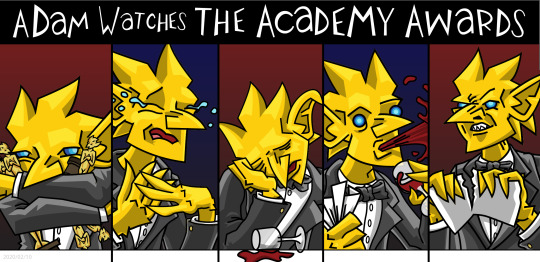
The 92nd Academy Awards have come and gone. As always, there’s plenty to be happy about and plenty that’ll make you wonder what the heck the voters were thinking. I watched the ceremony and while I may say that I don’t care… I do. Those awards are a big deal. Legions of people who would’ve otherwise dismissed Parasite as some movie that requires them to read subtitles saw it because it was nominated. One of those golden statues can make a career and let’s face it, you like to hear your love for something validated by people who have even the semblance of authority on the subject.
But here’s what you may not know: most of the voters really don’t know what they’re doing. While cinematographers NOMINATE what films are up for that Best Cinematography Award, EVERYONE in the Academy of Motion Picture Arts and Sciences gets to vote for the winner and there’s no guarantee they’ve actually seen every nominee, know what the technical terms mean or are voting because what they saw is what they actually believe was “the best”. Once you take into account the dollars required to produce a nomination campaign, the stigma many genre films face, the prejudices against certain types of roles and/or actors, and how popularity influences votes, a win hardly means more than a bunch of people you don’t know saying they liked a movie.
If you want a better idea of which of 2019’s films were “the best”, you’re better off asking someone you know and trust, someone who can prove they’ve done their homework and aren’t just voting for their friends, the one they’ve heard is good from their kid, or got a special gift basket from. I may not be a paid professional, but I have put in the time and effort to see EVERYTHING nominated (with a few exceptions I’ll detail below). Reviews for some of these (The Irishman, Judy) are coming to the blog in a couple of days. If it were up to me the list of nominees would be different but we’ll get to that later. Without further ado, here’s who SHOULD’VE won.
Best Visual Effects
1917 – Guillaume Rocheron, Greg Butler, and Dominic Tuohy The best special effects are the kind you don’t even notice. I couldn’t tell you where the explosions, sets, and actors in 1917 begin, and where the computer-generated imagery takes over. It’s seamless.
Best Film Editing
Parasite – Yang Jin-mo Got to hand it to Parasite for its amazing use of montage and the way it stitched its footage together. Some shots I initially thought initially were one take I realized under carefully scrutiny - and by that I mean frame-by-frame examination - were actually two melded together. The scenes showing how the Kim family infiltrate the Park’s household should be shown in film class to demonstrate how the art of montage is at its best should be done to maximum effect.
Best Costume Design
Little Women – Jacqueline Durran Funny how every single film nominated at the 92nd Academy Awards was a period piece. My vote goes to Little Women not because it was necessarily the most accurate (I couldn’t tell you what people wore in 1868) but because of the way the costumes were used. You can tell a lot about the characters from the multiple outfits they wear throughout the film - check out that purple bonnet adorned by Aunt Marsh (Meryl Streep).
Best Makeup and Hairstyling
Bombshell – Kazu Hiro, Anne Morgan, and Vivian Baker I called it when I reviewed the film. The makeup used to transform John Lithgow was nothing short of incredible. It was an easy pick.
Best Cinematography
1917 – Roger Deakins I’m glad to see The Lighthouse on this list but I have to hand it to 1917. The one-shot motif adds so much to the story. Then, there are the individual shots I remember so vividly. The quiet meadow just outside of No Man’s Land, the raging inferno Schofield sees when he wakes up, the trench he must run in front of to reach the Colonel are all shots that permanently imprint themselves into your memory.
Best Production Design
1917 – Production Design: Dennis Gassner; Set Decoration: Lee Sandales Tempted to hand it to Parasite for the house they constructed for the movie but I’m give it to 1917. The trenches, the blasted landscape of No Man’s Land still haunt me. When you see the craters, it’s jarring. Then, as your eyes become adjusted, you notice the rats. Then, the chunks of bone and charred meat that have now become part of the landscape. It’s horrific.
Best Sound Mixing
Ford v Ferrari – Paul Massey, David Giammarco, and Steven A. Morrow What you remember most from Ford v Ferrari is that big race at the end. The climax wouldn’t have been the same without the sounds we heard. The roar of the engines, the clacking and grinding as the pedals are pushed and gears are switched… the air rushing by. Out of the nominees, it’s the one whose sounds I most remember.
Best Sound Editing
Ford v Ferrari – Donald Sylvester This year, the Best Sound Editing award goes hand-in-hand with the sound mixing. Obviously, the actors were never moving at the kind of speeds depicted in Ford v Ferrari but you wouldn’t be able to tell because of the foley and sound design.
Best Original Song
Stand Up from Harriet – Music and Lyrics by Joshuah Brian Campbell and Cynthia Erivo Stand Up plays during the end credits of Harriet and it perfectly caps the film. Whenever I hear its lyrics, I’m transported back to that moment. It’s the most memorable and emotional song on this list.
Best Original Score
Joker – Hildur Guðnadóttir I chose the best song for its ability to stand out. In this category, Joker wins because its music doesn’t stand out… at least not at first. While you’re watching, those notes don’t draw attention to themselves. They subconsciously build the mood, augmenting the performance by Joaquin Phoenix, the visuals, and the story. You don’t notice how much of an effect it has on you until you see isolated clips. When you do, it’s shocking.
Best Animated Short Film
Abstaining (I’ve only seen Hair Love)
Best Live Action Short Film
Abstaining
Best Documentary Short Subject
Abstaining
Best Documentary Feature
Abstaining
Best International Feature Film
Abstaining, as I’ve only seen 2 films (Pain and Glory and Parasite)
Best Animated Feature Film
I Lost My Body – Jérémy Clapin and Marc du Pontavice I Lost My Body is the most audacious and inspired of the animated films nominated. The only movie among these to be aimed at adults, it often tells its story through visuals alone but when you get to the end, you realize it’s about more than just what was on-screen.
Best Adapted Screenplay
Little Women – Greta Gerwig based on the novel by Louisa May Alcott Greta Gerwig does more than merely adapt the classic novel, she breathes new life into it, makes it her own, makes it feel wholly new and modern. This version of the film surpasses all others we’ve seen before because of the changes she’s made to the story’s structure.
Best Original Screenplay
Knives Out – Rian Johnson What a ride Knives Out was. It’s got so many twists and turns, so many delightful characters you want to re-watch it the second it’s over so that you are no longer distracted by its central mystery and can simply step back and admire the handiwork by Rian Johnson. A sequel’s been announced and I can’t wait to see it.
Best Supporting Actress
Laura Dern – Marriage Story as Nora Fanshaw Laura Dern was also in Little Women and her two roles couldn’t be more different. Here, she’s loathsome and captivating. As soon as I saw Nora take off her shoes before she kneeled down on the couch to console Nicole, I knew there was a whole lot more to her character than what we were told. The more you see her, the more you want.
Best Supporting Actor
Al Pacino – The Irishman as Jimmy Hoffa Al Pacino has the advantage of getting A LOT of screen time as Jimmy Hoffa. The Irishman clocks in at over 3,5 hours and he isn’t in the whole movie but when he is, the seasoned performer gives us so much. At different periods of the story, you’ll feel differently about him. There’s no point comparing him to the real-life person. He takes the meaty role and makes it his own. His voice, his mannerisms, I can’t think of anyone who could’ve done it better.
Best Actress
Renée Zellweger – Judy as Judy Garland Judy was the very last movie on my list to watch, having missed it when it came to theatres. When I think back to Zellweger’s performance, I don’t see her. All I see is her character, a rich, complex person you sometimes hate, sometimes love and feel sorry for. The movie is not going to be on my “Best of” list but she is.
Best Actor
Joaquin Phoenix – Joker as Arthur Fleck / Joker To me, there was no question Joaquin Phoenix would take this one. I saw Joker three times and each time, I found something new in his performance.
Best Director
Sam Mendes – 1917 With this award, I’m awarding Sam Mendes for the craft he displayed in 1917. It’s such a visceral experience that when people asked me how it compared to Dunkirk, it felt weird to lump both together. This is coming from someone who gave both pictures a 5-star review, who put both on their respective “best of the year” lists. It’s a movie I’m going to go back to and wondering “how did they do that?!
Best Picture
Little Women – Amy Pascal It’s a tough call for me this year, partially because I loved Parasite, 1917, Joker, and others so much. I’m planning on adding those three films to my collection so I can pop them into my Blu-ray player any times I feel like it. That said, I would’ve given the Best Picture Award to Little Women. You’re so emotionally invested in this little story that telling you why with merely words is impossible. You fall in love over and over. It made me cry and every time I think back to that scene at Christmas, I tear up again. I’m choosing it because of all the things it does differently from the other films. At the end of the day, it isn’t a big story. It isn’t about people with guns, corruption, war, a turning point in history or even necessarily the biggest event in the lives of the characters but it feels like it is. That’s exactly why it’s so good.
Disagree with my choices? I don’t blame you. What kind of idiot finds a way to leave out Marriage Story from their list? You let me know where it should’ve gone. Hopefully, commenting keep you warm until MY Best of 2019 list gets posted in the next few days.

#Academy Awards#Oscars#2019 Oscars#2020 Oscars#parasite#ford v ferrari#the irisnman#jojo rabbit#joker#little women#marriage story#1917#once upon a time in hollywood#judy#the two popes#bombshell#knives out#toy story 4#i lost my body#klaus#missing link#pain and glory
38 notes
·
View notes
Text
FEATURE: Visual Novels Strike Back in Fall 2020

Content Warning: While otherwise safe for work, this article discusses games made in Japan's 18+ visual novel industry. It does not talk about individual games in-depth, or detail any offensive content contained within; nevertheless, curious readers should expect those games to be suitable only for adult audiences.
One of the more memorable first episodes of anime this fall was Talentless Nana, a thriller series starring a young student with a dark secret. Curious to see why my friends were excited about it, I did some research of my own and found something bizarre in the process. Talentless Nana was based on a manga whose story was written under a pseudonym: looseboy. "Could this be the looseboy I know?" I posted on Twitter in a daze. "looseboy, the porn game writer?"
Like the main character of Talentless Nana, as a young student, I too had a dark secret: I played visual novels. I read all three routes of Fate/stay Night. I soldiered through Muv Luv. I sought out the anime Humanity is Declined specifically because the source text was written by visual novel luminary Romeo Tanaka. These games could be overstuffed, repetitive, and deeply sexist. But don't underestimate visual novels. YU-NO upended conventions in 1996 in such a way that modern games steal its twists and are still labeled forward-thinking. Infamous video game auteur Hideo Kojima cut his teeth working on spin-offs in the hugely influential Tokimeki Memorial series. And Hajime Isayama, the creator of Attack on Titan, admitted in this interview in Brutus Magazine that he had been inspired by the 18+ mecha epic Muv Luv Alternative.
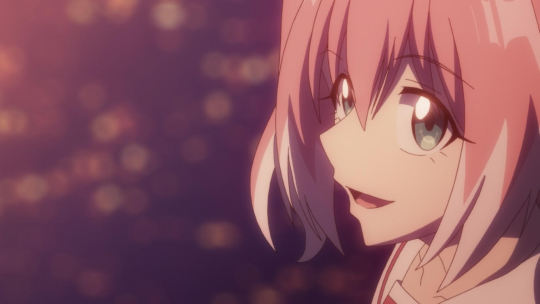
Image via Funimation
During my student years, some of the most popular games in the field (at least among English speaking fans) were those with scripts by looseboy — most famously, Sharin no Kuni and The Devil on G String. Games remembered for their memorable protagonists, tear-jerking melodrama, and shocking twists and turns. They also had sex scenes in them (not very good ones) because that's what games of that type were supposed to have. It had been years since I'd thought about Sharin no Kuni — I wasn't even sure if I still liked it. But here looseboy was again, in a completely different medium, shocking a whole new audience of readers and viewers.
For visual novel fans, this fall season of anime is a bonanza. You have a remake (or is it) of rural horror epic Higurashi: When They Cry, masterminded by creator Ryukishi07. You have a new original series, The Day I Became a God, scripted by crying game grandmaster Jun Maeda and his buddies at PA Works. Then there's Akudama Drive, an explosive SF grindhouse series based on a concept by Danganronpa scribe Kazutaka Kodaka.
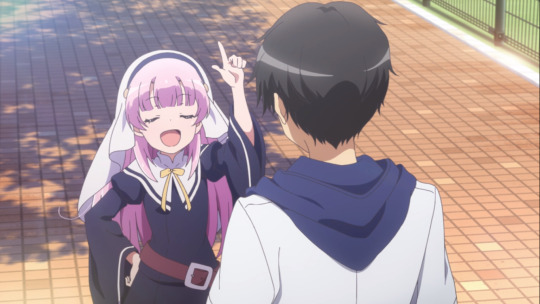
Image via Hulu
It hasn't always been like this. In the past few years, light novels have outstripped visual novels as the source material of choice in the adaptation coal mines. Series like Higurashi or Clannad that were popular in the 2000s were gradually replaced in the popular imagination by newer works like Re:ZERO -Starting Life in Another World- and My Teen Romantic Comedy SNAFU. Kyoto Animation, a studio once known for producing lavishly animated renditions of games made by the studio Key, pivoted years ago to adapting light novels and manga (not to mention its own original works). It's not difficult to see why; light novels, manga, and even proper novels are easier to adapt to the medium than visual novels. It's already difficult to squeeze the multi-route structure of often stupendously long video games into the time limitations of anime — not to mention their sometimes deeply gross and problematic content, sudden perspective switches, and even total changes in genre. It took years for the creators of Fate/stay Night to figure out how to make its full story comprehensible to a wide audience. What hope could anybody else have?
Meanwhile, the visual novel industry is changing. Some of the talent I followed in the 2000s are doing just fine. Fate/GO, a phone game written by Fate/stay Night creator Kinoko Nasu and his team of former industry luminaries, became popular not despite the long and convoluted visual novel bolted to its gambling simulator but because of it. STEINS;GATE and its progeny continue to thrive, and Ryukishi07 — the creator of Higurashi and the later Umineko: When They Cry — toils on his new magnum opus. Other creators in the field are struggling. The visual novel company light — producer of chuuni games like dies irae — folded last year due to poor management. OVERDRIVE — known for music-inspired visual novels like Kira Kira — labeled its newest title Muscius! as its "Final Project."In the United States, an early boom in Kickstarters and English translations — with former fan translators gladly pitching in with their expertise — gradually stalled under claims of exploitative working conditions and Steam's hot-and-cold relationship with the medium as a whole. In the face of the popularity of anime, manga, and even light novels, it's hard not to see much of the visual novel industry's old guard as a tiny, stagnant niche.

Image via Hulu
But the medium's heart still beats in all-ages visual novels, thanks to the sudden success of two new stars. Kotaro Ucihikoshi — co-writer on cult visual novel Ever17 — found surprising success in the United States with his twisty pseudoscientific thriller 999. Kazutaka Kodaka's hilariously crude and violent (yet deeply heartfelt!) Danganronpa series has built a hardcore fanbase willing to grapple with each entry's whiplash-inducing twists and turns. It's no surprise, then, that the two of them have found their way into the anime field. Uchikoshi contributed the script to MAPPA's underrated sex comedy PUNCH LINE, while Kazutaka Kodaka worked with hardcore games nerd Seiji Kishi to produce anime-original sequels to the Danganronpa games. Uchikoshi and Kodaka now work together at the company Too Kyo Games, one of Japan's most promising "middleware" developers. Their name is front and center on this fall's Akudama Drive.
The anime industry itself has become steadily riddled with former visual novel writers. Gen Urobuchi, the scriptwriter of 2011 smash hit Puella Magi Madoka Magica, got his start writing shock-horror games like Saya no Uta. His work on PSYCHO-PASS (and love of martial arts) is foreshadowed by his earlier writing for cyberpunk games like Kikokugai: The Cyber Slayer. Then you have the creative lead on popular visual novel White Album 2, Fumiaki Maruto, who went on to script Classroom Crisis together with the director who went on to adapt My Hero Academia at BONES. And my favorite episode of schoolgirl horror anime SCHOOL-LIVE! — the third, from the perspective of the teacher Megane — was scripted by visual novel writer Hikaru Sakurai, now busy writing for Fate/GO.
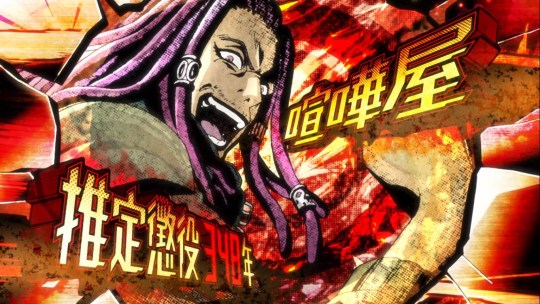
Image via Hulu
If visual novels are often overlooked by the mainstream games press, their influence on pop culture is stronger than ever. The Persona games, an inspiration on everything from Fire Emblem: Three Houses to Supergiant's recent indie classic Hades, take heavy influence from dating sims. The deeply weird action-RPG Nier Automata, which made a legend of its director Yoko Taro despite being released in the shadow of The Legend of Zelda: Breath of the Wild back in 2016, takes undeniable influence from visual novels and the denpa (a person who feels disconnected from those around them) aesthetic. Even developers outside of Japan are paying homage with vaporwave mystery drama Paradise Killer seeking to beat Danganronpa at its own maximalist game.
Yet it's projects like Talentless Nana that stick with me — looseboy made his name working on small games highly prized by a few. But he jumped ship to the manga world and now a comic popular enough to receive an anime adaptation bears his name. How many other visual novel writers from the old 18+ market are out there working under pseudonyms on manga and in other fields? How far does the influence spread? Will we see Shumon Yuu or SCA-JI writing for anime? Only time will tell.
What is your favorite series airing this year from former visual novel talent? What visual novel would you love to see adapted into an anime? Did you know that you can now pick up The House in Fata Morgana at the incredible price of 0 percent off? Let us know in the comments!

Adam W is a Features Writer at Crunchyroll. When he isn't fervently praying that Girls' Work still has a chance of being made, he sporadically contributes with a loose coalition of friends to a blog called Isn't it Electrifying? You can find him on Twitter at: @wendeego
Do you love writing? Do you love anime? If you have an idea for a features story, pitch it to Crunchyroll Features!
0 notes
Note
All aboard the hype train! What were your top 3 most stand out moments from THW? (in no particular order)
Hype hype! My list of three will be a little different than the raving I’ve seen many fans do. For me, my top three stand out scenes are:
There were dragons when I was a boy. I have the opening of Cressida Cowell’s book memorized. I about screamed when I heard, in the trailers, Hiccup saying its first line. But my heart has, for over five years, yearned for Hiccup to say not just that line, but the whole speech. For him to talk about “great, grim, skydragons that nested on the cliff tops like gigantic scary birds” and “little brown scuttly dragons” and “preposterously huge Sea Dragons.” The opening to the first How to Train Your Dragon book is simple, eloquent, emotive, poignant magic, and there was nothing I wanted more than for the DreamWorks films to give us a chance to hear that aloud. Did I expect to hear it? Not really, not fully - maybe a modified version of the concepts.But we got that word-per-word moment! Not every word on the page, but a good chunk nevertheless. I flailed in theatres. I remember hearing about Spielberg crying through reading the last page of the THW script; I know now it had to be this quote. I find that interesting and ironic, because while that story got stocked up as Dean DeBlois working writing wonders, the tears are really to the credit of Cressida Cowell. These are her words, integrated into both the book!verse and the movie!verse; they sing whichever How to Train Your Dragon story you put them in. I for one am a fan that we could get this adapted to screen, so that all HTTYD lovers can get this bittersweet speech.The combination of the lines plus seeing Hiccup with his family, reuniting with Toothless, was rather well-done, and certainly one of the best moments of the film.
Save him. It’s easy for your breath to catch. For a gasp to slip out from your lips. For your heart to skip a beat. Hiccup literally lets go and falls, sacrificing himself with the intent for Toothless to live. Hiccup plummets from the sky, Grimmel ripping his dragon scale armor suit to shreds, while the Light Fury flies off to catch Toothless’ fall. The sound editing was perfect, sudden muted silence, a sense of surrealism as we watch what could so easily have been Hiccup’s death. It’s a moment of ultimate sacrifice, of both emotionally and literally letting go, for the sake of someone else’s life. What a moment. What a moment.Not going to lie, I lowkey wanted him to die in this moment, it was so damn cool.
The opening fight. What a fun adventure! This scene hits multiple things close to my heart. First: the gang dynamics. We got Snotlout setting his butt on fire (hello ROB/DOB reference), Hiccup being mistaken for a demon, the twins heckling each other constantly, and more. Character dynamics like this are my favorite thing about the DreamWorks Dragons show, and character dynamics tend to be my favorite thing about any franchise that does them well (VLD, ATLA, ST:TOS, LOTR movies, etc.). They’re so… mmmm… vibrant and rich… when everyone shines individually and bounces off one another for a greater whole. I could write essays on it.Then we got a battle - complete with Hiccup sword fighting. Since reading the HTTYD books, I have been in love with every second I see Hiccup holding a sword. Granted, I’m a huge sap for swords period, but Hiccup with a sword is such an aesthetic! Such a mood! Watching everyone run around in a dramatic action moment like this was a treat I can’t put into words. They literally combined character dynamics, which I’m a sap for, with characters fighting with swords dramatically, which I’m a sap for.On top of that all, we have amazing dramatic lighting (the deep haze??? the fire??? the darkness??? SO GOOD) which created such an AMBIANCE. And when they flew to Berk, both my friend and I in the theatres gasped the same two words at the same time: “Holy shit.” I’d seen what Berk looked like from previews, but nothing prepared me for seeing the detailed magnificence and ridiculous visual appeal on an enormous theatre screen.The opening sets up what so many of THW strengths are: the character interactions, the unreally beautiful animation, the high stakes action. It also pulls in the crux of the plot. Other people might not see this moment as spectacularly as I do, but for me it was a real treat. A REAL treat.
#httyd 3 spoilers#THW spoilers#httyd3#httyd 3#How to Train Your Dragon 3#THW#The Hidden World#analysis#my analysis#ask#ask me#awesome anonymous friend#Anonymous
187 notes
·
View notes
Text
2020 Oscars Predictions
So, it’s 2020 & here I’m again predicting Oscars. Until the last year, I wasn't predicting the following categories: Animated Feature, Documentary Feature, Documentary Short, Short Film Animated & Animated Live Action because I hadn't watched those. I still don't watch them but I just felt like filling in the ballot completely just like the last year. I feel like there has to be some surprises because it's been so predictable this year. So, I'm going to take a risk with my picks.
BEST PICTURE: Any of these can win: 1917, Jojo Rabbit, Joker, Once Upon a Time in Hollywood and Parasite. The race looks like its among 1917, Once Upon a Time in Hollywood and Parasite. They seem to be favorites of anonymous Oscar voters. However, Parasite's only disadvantage is that it's a foreign language film. There were like 17 members who didn't want to bother watching it because they were distracted with reading subtitles. Maybe, there are more than 17. I think, Jojo Rabbit and Joker are wild cards. My personal favorite is definitely Joker. It might have received a lot of backlashes and might have been found controversial but I think people are missing its point by focusing on violence. Joker delivers a great message regarding mental illness and society's attitudes. Jojo Rabbit is a great satire about WW2. It's not as anti-semitic and offensive as some Academy members claim. It gives a lesson to Nazis by trying to free them from Nazi ideology. Parasite is a social class commentary. If it wins, it'd be groundbreaking since a foreign language film would break down the language barrier and break down through the bias. So, these 3 movies give a powerful message. What does 1917 and OUATIH do? 1917 lets audience be a part of the film. That's how it might beat other films. However, OUATIH is an entertaining Hollywood themed story with an alternative ending that's too good to be true. It makes audience wish that ending was the real ending but it's not as powerful as the others. It just appeals to the Academy because of its Hollywood theme. The Academy could relate to OUATIH but could the audience yet more the world relate themselves to OUATIH? The answer is no. The best picture must be a movie that would appeal to everyone. There's also something I noticed. In the previous decade, it didn't matter if BP winners won both GG and BAFTA or either GG or BAFTA. However, their screenplay win usually mattered. The movies, that won either best original or adapted screenplay, usually won the BP. If that would be the case, any of these 5 movies could win both screenplay and BP. If it doesn't happen to be case, usually the ones that win the best directing also wins BP which would mean 1917 would be the winner. Will win: Joker Could win: 1917 Should win: Parasite
BEST DIRECTOR: Although Bong Joon-Ho did a great job with Parasite, Sam Mendes did wonders with 1917. Will win: Sam Mendes Could win: Bong Joon-Ho Should win: Sam Mendes
BEST ORIGINAL SCREENPLAY: Either Parasite or Once Upon a Time in Hollywood will win it. Will win: Parasite Could win: Once Upon a Time in Hollywood Should win: Parasite
BEST ADAPTED SCREENPLAY: It seems as if this race is between Jojo Rabbit and Little Women. But it should be among Jojo Rabbit, Joker and the Two Popes. Jojo Rabbit is a nicely written satire. Joker has a background story for the first time ever. The Two Popes is about finding a common ground in spite of polarizing opinions. Moreover, it made the Popes look sympathetic! As a fan of Louisa May Alcott's Little Women, I was disappointed with Greta Gerwig. She's being overrated. If the original screenplay doesn't win BP, that would lower Little Women's chances at winning best adapted screenplay since it's not likely for it to win for BP. Will win: Jojo Rabbit Could win: Little Women Should win: Joker
BEST LEADING ACTOR: Joaquin Phoenix is going to get that Oscar. His biggest competitors are Adam Driver and Antonio Banderas. Will win: Joaquin Phoenix Could win: Adam Driver Should win: Joaquin Phoenix
BEST LEADING ACTRESS: Renée Zellweger is probably going to win. Her greatest competitors are Charlize Theron and Scarlett Johansson. Will win: Renée Zellweger Could win: Scarlett Johansson Should win: Renée Zellweger
BEST SUPPORTING ACTOR: Brad Pitt is going to win. His other competitors seem like they all gave equal performances. Will win: Brad Pitt Could win: Joe Pesci Should win: Brad Pitt
BEST SUPPORTING ACTRESS: Laura Dern is probably sweeping but Florence Pugh, Margot Robbie and Scarlett Johansson are also favorites! Especially, Scarlett Johansson! Will win: Laura Dern Could win: Scarlett Johansson Should win: Scarlett Johansson
BEST CINEMATOGRAPHY: 1917 and the Lighthouse are marvelous in terms of cinematography. 1917 is going to take the trophy though. Will win: 1917 Could win: The Lighthouse Should win: 1917
BEST FILM EDITING: Ford v Ferrari is probably going to win. If it doesn't, Parasite better win it since the Irishman's editing is faulty. Will win: Ford v Ferrari Could win: Parasite Should win: Ford v Ferrari
BEST VISUAL EFFECTS: The Irishman shouldn't win that de-aging effect since it wasn't compatible with the actors' motor movements and postures. Either 1917 or Avengers: Endgame is going to win. Especially, 1917's visual effects are so realistic. Will win: 1917 Could win: Avengers: Endgame Should win: 1917
BEST COSTUME DESIGN: Since period movies usually win costume design, I think Little Women will beat Jojo Rabbit and Once Upon a Time in Hollywood. Will win: Little Women Could win: Jojo Rabbit Should win: Once Upon a Time in Hollywood
BEST MAKEUP & HAIRSTYLING: This is the trickiest category to predict but I think Bombshell is going to win. Will win: Bombshell Could win: Joker Should win: Joker
BEST PRODUCTION DESIGN: 1917 and Once Upon a Time in Hollywood have the best production designs, in my opinion. Parasite's production design is really good, too. Will win: 1917 Could win: Once Upon a Time in Hollywood Should win: 1917
BEST ORIGINAL SCORE: 1917 and Joker's scores are the most mesmerizing ones. Will win: Joker Could win: 1917 Should win: Joker
BEST ORIGINAL SONG: Rocketman and Harriet's songs are really good. Will win: Rocketman Could win: Harriet Should win: Rocketman
BEST SOUND EDITING: Since war related films usually win in this category, 1917 is probably going to win. Will win: 1917 Could win: Ford v Ferrari Should win: 1917
BEST SOUND MIXING: Although space related films usually do well in this category, it seems as if Ad Astra's chances are really low. 1917 and Ford v Ferrari's chances seem to be the highest. Will win: Ford v Ferrari Could win: 1917 Should win: Ford v Ferrari
BEST INTERNATIONAL FILM: Parasite is the obvious frontrunner here. Then, probably follows Pain & Glory. Parasite will win it. It must win! Will win: Parasite Could win: Parasite Should win: Parasite
BEST ANIMATED FEATURE: Toy Story 4 or Missing Link might seem like obvious choices but I think the race should be between I Lost My Body and Klaus. Will win: I Lost My Body Could win: Klaus Should win: I Lost My Body
BEST DOCUMENTARY FEATURE: American Factory, For Sama or Honeyland... Which one should win? Will win: For Sama Could win: American Factory Should win: Honeyland
BEST ANIMATED SHORT: Will win: Hair Love Could win: Memorable Will win: Hair Love
BEST DOCUMENTARY SHORT: Will win: Learning to Skateboard in a War Zone Could win: Walk Run Cha-Cha Should win: Learning to Skateboard in a War Zone
BEST LIVE ACTION SHORT: Will win: Brotherhood Could win: The Neighbor's Window Should win: Brotherhood
Let’s discuss the potential winners here.
P.S. I posted my predictions on letterboxd and instagram as well. If you have a letterboxd or instagram account, feel free to like my posts and follow my there.
#oscars#oscars 2020#2020 oscars#joker#parasite#1917#jojo rabbit#once upon a time in hollywood#ouatih#the academy awards#92nd academy awards#92nd Oscars#2020 oscars predictions#2020 oscar reviews#oscars predictions#2020 oscar predictions#oscar predictions#2020 oscars reviews#predictions#reviews#review#letterboxd#instagram
1 note
·
View note